Posts Tagged by matt anderson
The 1963 Mustang II: A Not-So-Missing Link
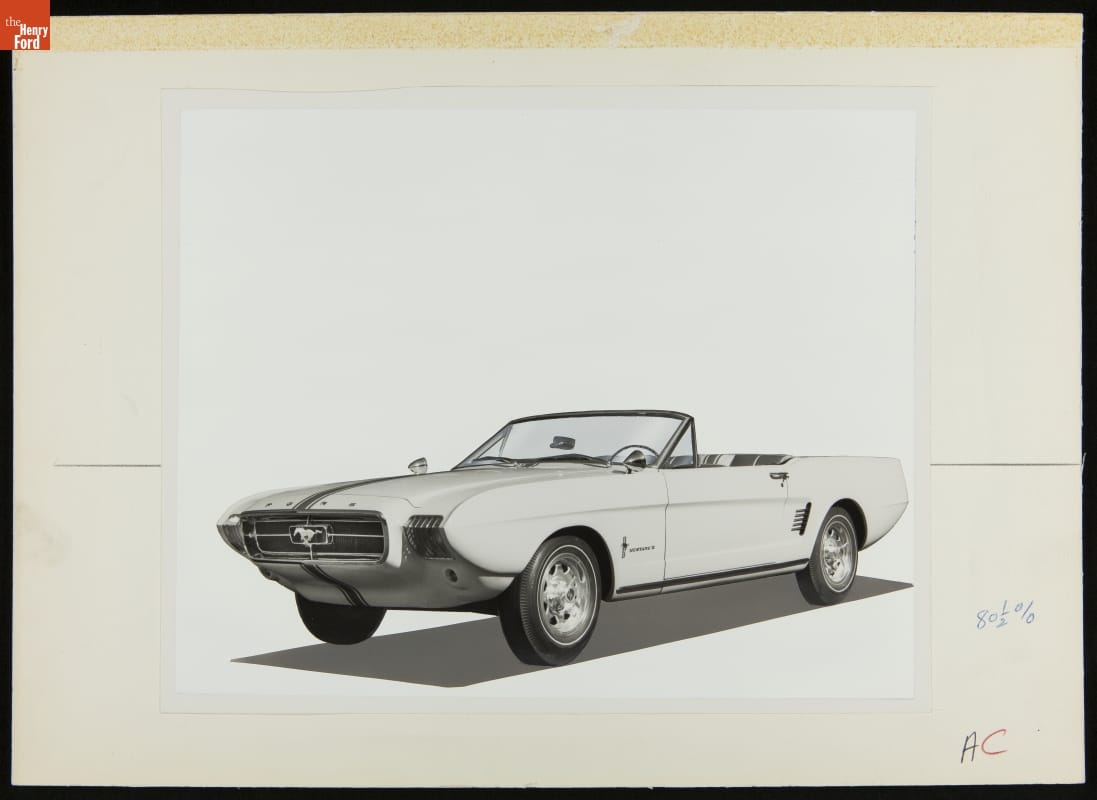
THF233334 / Advertising Process Photograph Showing the 1963 Ford Mustang II Concept Car.
The 1963 Mustang II (not to be confused with the Ford Pinto-based production Mustang II of the 1970s) surely is one of the most unusual concept cars ever built. Industry practice (and common sense) tells us that an automaker builds a concept car as a kind of far-out “dream car” to generate excitement at car shows. Most never go past the concept stage, but a few do make it into regular production. (Chevrolet’s Corvette and Dodge’s Viper are notable examples.) The Mustang II previewed the production Ford Mustang we all know and love, but the concept car was designed and built after the production Mustang project already was well underway! Why? It’s a case of managing public expectations.
Most Mustang histories start with the 1962 Mustang I, but devoted pony fans know that Mustang I was an entirely separate project from the production car. Ford built the “Mustang Experimental Sports Car” (its original name – the “I” was a retrospective addition) to spark interest in the company’s activities. Ford was going back into racing and looking for a quick way to create some buzz about the exciting things happening in Dearborn. The plan worked a bit too well. When Mustang I debuted at Watkins Glen in October 1962, and then hit the car show circuit, the public went crazy and sent countless letters to Ford begging the company to put the little two-seater into production.
At the same time Mustang I was being built, another team at Ford was working on the production Mustang that would debut in April 1964. Mustang I’s popularity created a problem: Everyone loved the two-seat race car, but would they feel the same about the four-seat version? The solution was to build a new four-seat prototype closely based on the production Mustang’s design.
Enter the 1963 Mustang II.
The new concept car wasn’t just based on the production Mustang’s design – it was actually built from a prototype production Mustang body. Ford designers removed the front and rear bumpers, altered the headlights and grille treatment, and fitted Mustang II with a removable roof. While the car looked different from the production Mustang, a few of the production car’s trademark styling cues were retained, including the C-shaped side sculpting and the tri-bar taillights. Mustang II also consciously borrowed from Mustang I, employing the 1962 car’s distinct white paint and blue racing stripes. Conceptually and physically, the four-seat Mustang II formed a bridge linking the 1962 Mustang I with the 1965 production car. Mustang II was a hit when it debuted at Watkins Glen in October 1963, and when the production version premiered six months later, there were few complaints about the four seats instead of two.
Fortunately, Mustang II is one “link” that isn’t “missing.” The Detroit Historical Society acquired the car in 1975 and has taken great care of it ever since.
View artifacts related to Mustang II in The Henry Ford’s Digital Collections.
Matt Anderson is Curator of Transportation at The Henry Ford.
Michigan, 20th century, 1960s, Mustangs, Ford Motor Company, convertibles, cars, by Matt Anderson
The Mark IV Visits the 2017 SEMA Show
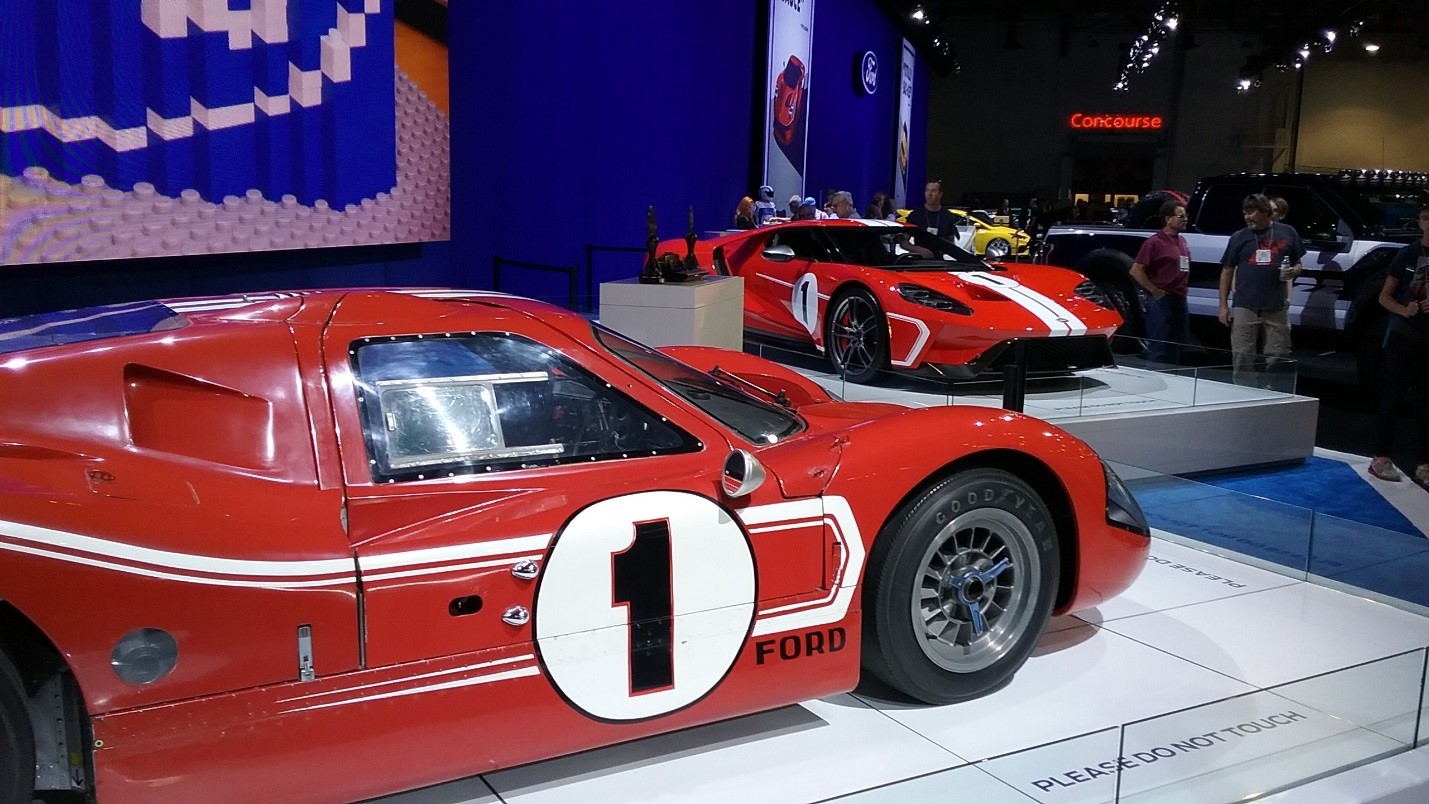
Our 1967 Ford Mark IV at SEMA with the 2018 GT Heritage Edition it inspired.
It’s been a busy couple of years for our 1967 Ford Mark IV. In the last 24 months, the car traveled to England, France, California and, most recently, Nevada. Race fans have welcomed the car at each stop, excited to see it 50 years after its Le Mans win with Dan Gurney and A.J. Foyt. The car’s trip to the Silver State coincided with this year’s SEMA Show, presented by the Specialty Equipment Market Association from October 31-November 3 in Las Vegas.
The SEMA Show is among the largest automotive trade shows on the calendar. It brings together original equipment manufacturers, aftermarket suppliers, dealers, restoration specialists and more. SEMA draws some 2,400 exhibitors and 160,000 people (all of them industry professionals – the show isn’t open to the public) to the Las Vegas Convention Center each year. You’ll find a bit of everything spread over the show’s one million square feet of exhibit space: speed shop equipment, specialty wheels and tires, seats and upholstery, car audio systems, paints and finishes, motor oils and additives – basically, anything that makes a car run, look, sound or feel better.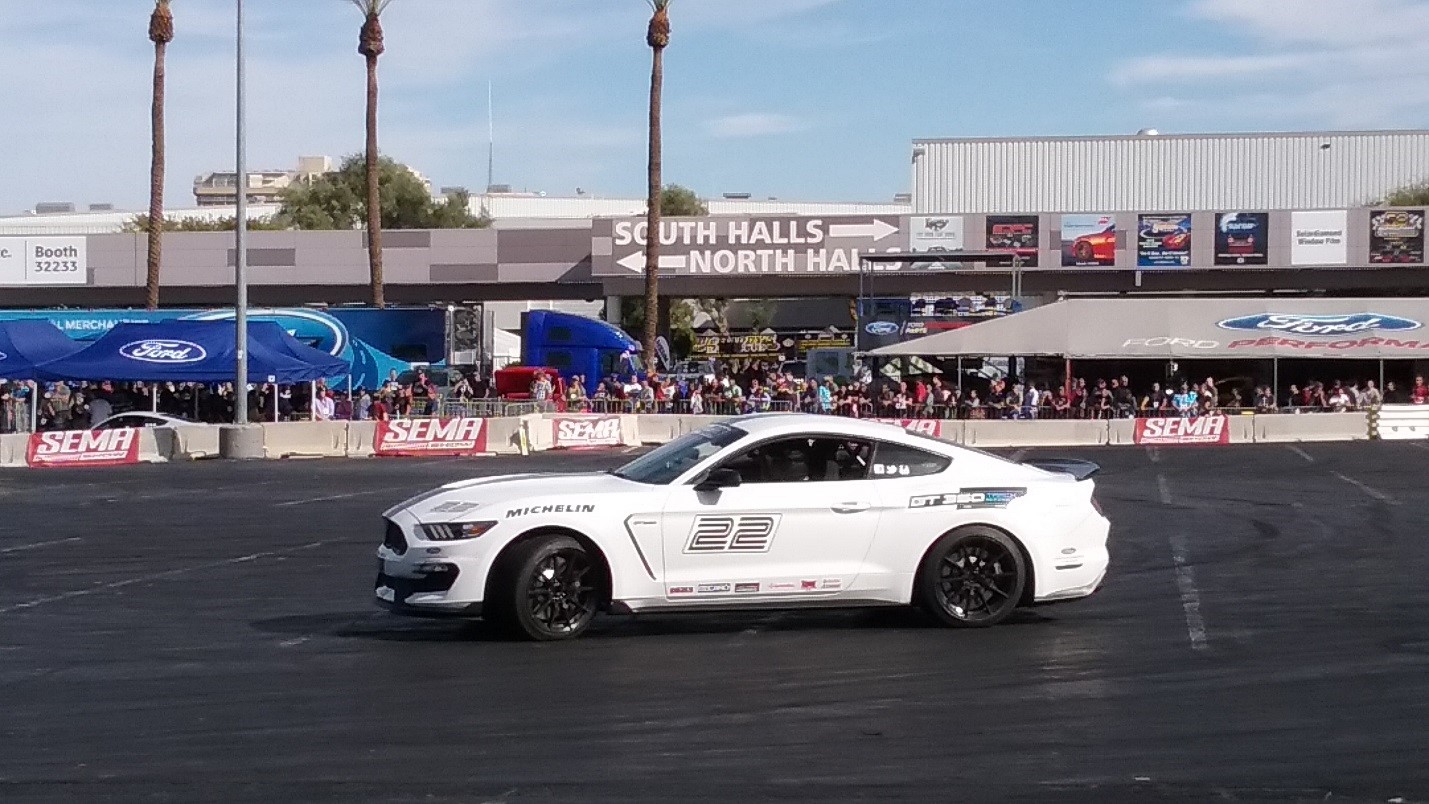 Ford provided (joyously tire-shredding) rides in Raptors, Focus RS hatches and Mustang GT350s.
Ford provided (joyously tire-shredding) rides in Raptors, Focus RS hatches and Mustang GT350s.
Our Mark IV was given an honored place in Ford Motor Company’s main exhibit, where it was paired with the 2018 GT Heritage Edition that pays tribute to the Gurney/Foyt win. Ford’s exhibits continued outside the Convention Center in the “Ford Out Front” area. Jersey barriers formed an impromptu track in the parking lot, where attendees could ride with a professional driver in a Mustang GT350, a Focus RS, or an F-150 Raptor. Believe me, you haven’t seen drifting until you’ve seen it done with a pickup truck.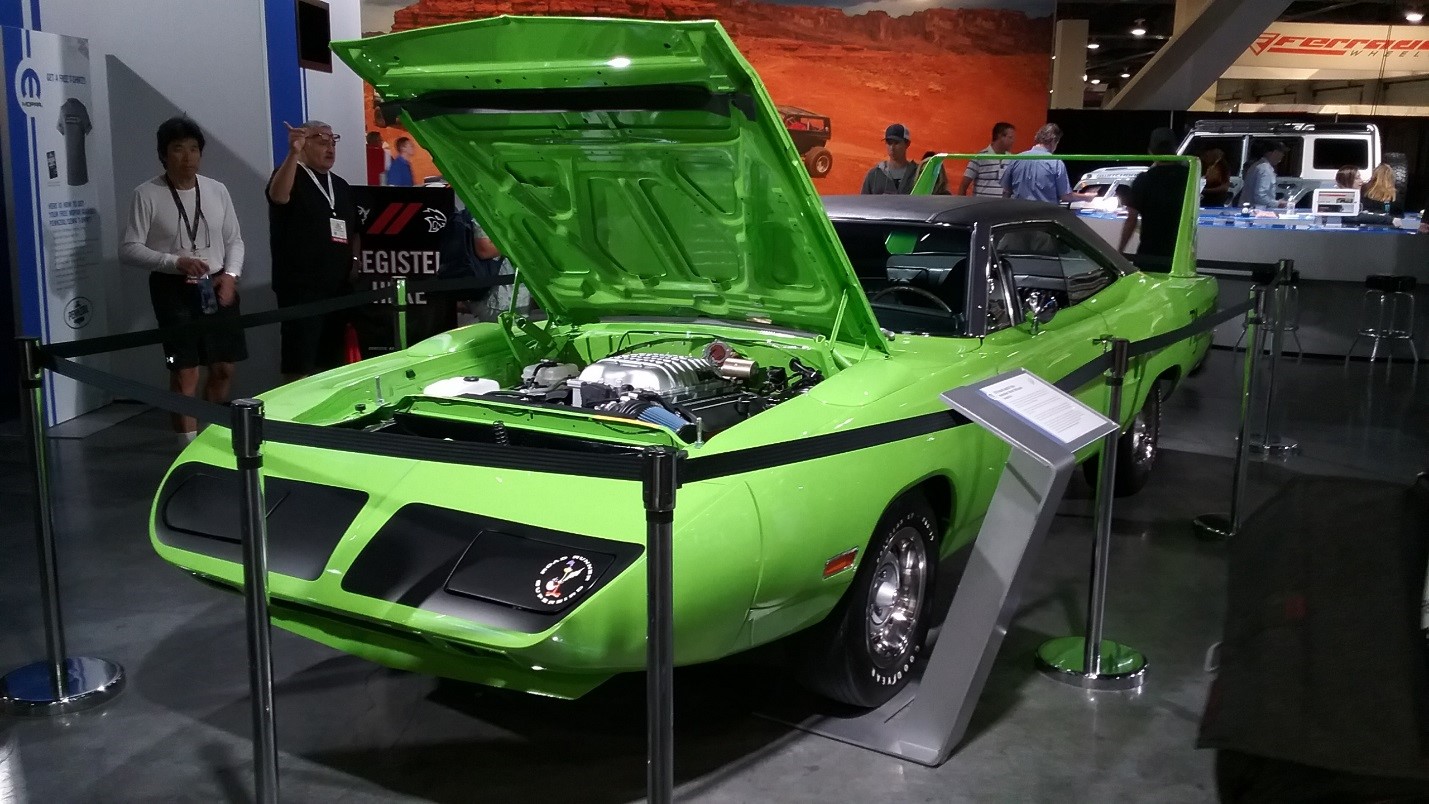 The American Southwest, native habitat of the Roadrunner – like this 1970 Superbird tribute car.
The American Southwest, native habitat of the Roadrunner – like this 1970 Superbird tribute car.
Of course, Ford wasn’t the only OEM in town. Chevrolet, FCA, Toyota, Audi, Honda and Hyundai all had a presence at the show. Chevy brought its new special edition Camaro, honoring the 50th anniversary of Hot Wheels diecast cars, while FCA celebrated all things Mopar. Toyota, marking the 60th anniversary of its U.S. sales arm, brought Camrys representing each of that venerable model’s eight styling generations.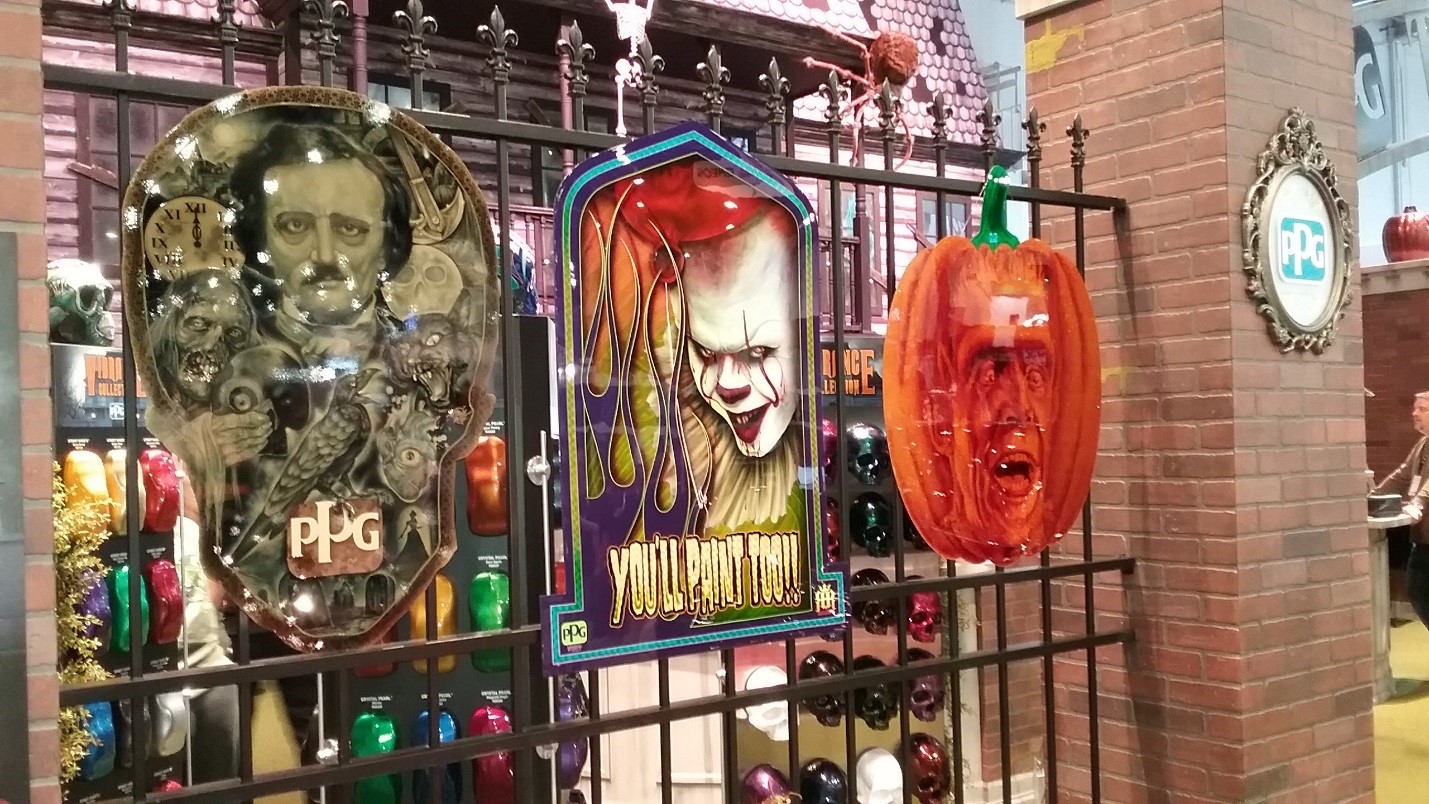 PPG Paints displayed airbrushed portraits of this terrorsome trio: Edgar Allan Poe, Pennywise and Herman Munster.
PPG Paints displayed airbrushed portraits of this terrorsome trio: Edgar Allan Poe, Pennywise and Herman Munster.
PPG Paints gets my vote for most elaborate show booth. Embracing SEMA’s opening date of October 31, the company built a giant haunted house, complete with cars and parts strewn about the front lawn called – what else – “The Boneyard.” The surrounding fence was decorated with incredible airbrush art celebrating Halloween heroes like Edgar Allan Poe and Herman Munster.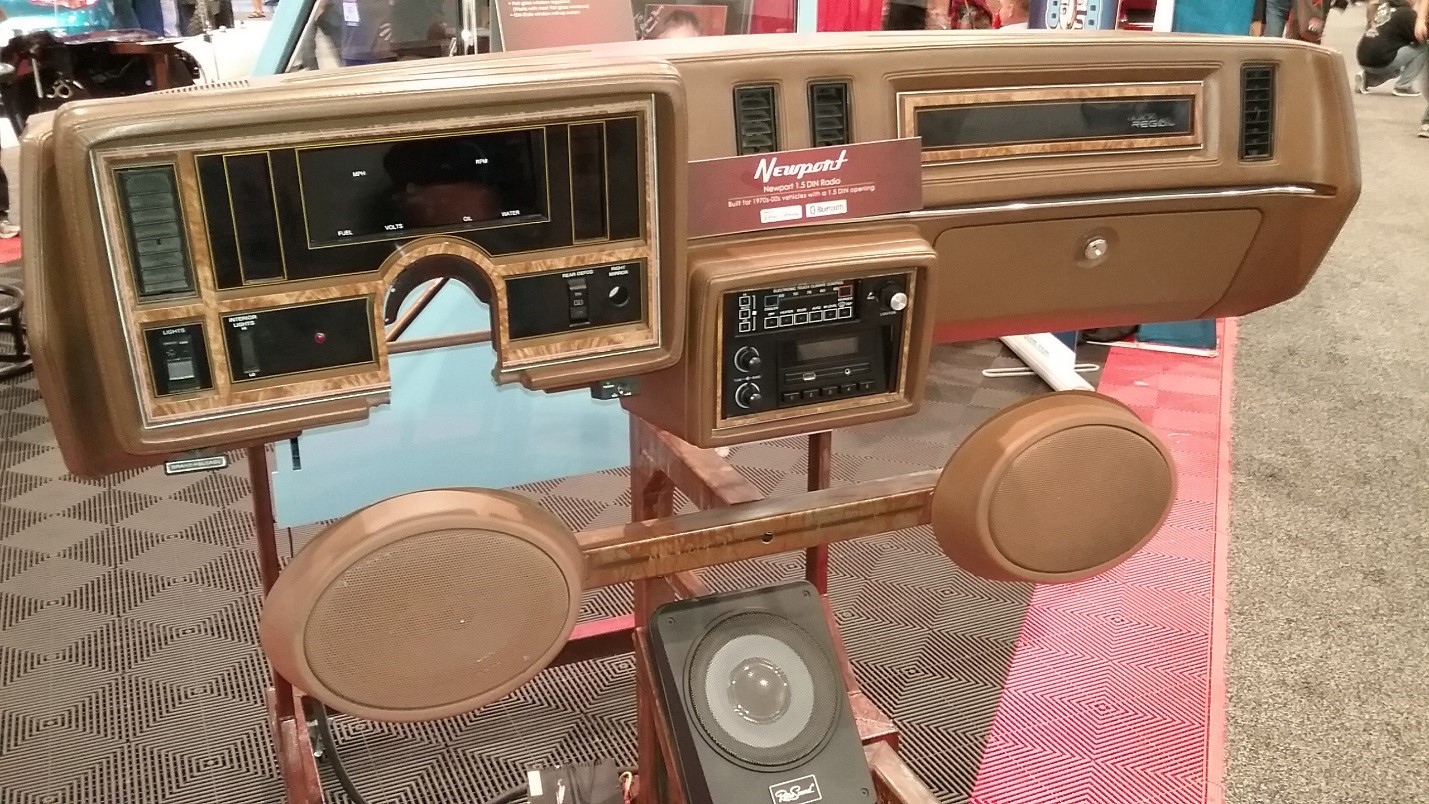 Having a hard time finding new cassettes for your mid-1980s Buick Regal? Retro Manufacturing will sell you a perfect-match stereo with a USB port.
Having a hard time finding new cassettes for your mid-1980s Buick Regal? Retro Manufacturing will sell you a perfect-match stereo with a USB port.
More than a few vendors drew crowds to their booths with the help of celebrity appearances. Walk around and you’d spot stars from every field of automotive endeavor. There were drivers (Emerson Fittipaldi, Ken Block), television hosts (Jessi Combs, Dennis Gage), custom builders (Gene Winfield, Chip Foose), rock stars (Jeff Beck, Billy Gibbons), and all-around icons (Linda Vaughn, Richard Petty, Jay Leno, Mario Andretti).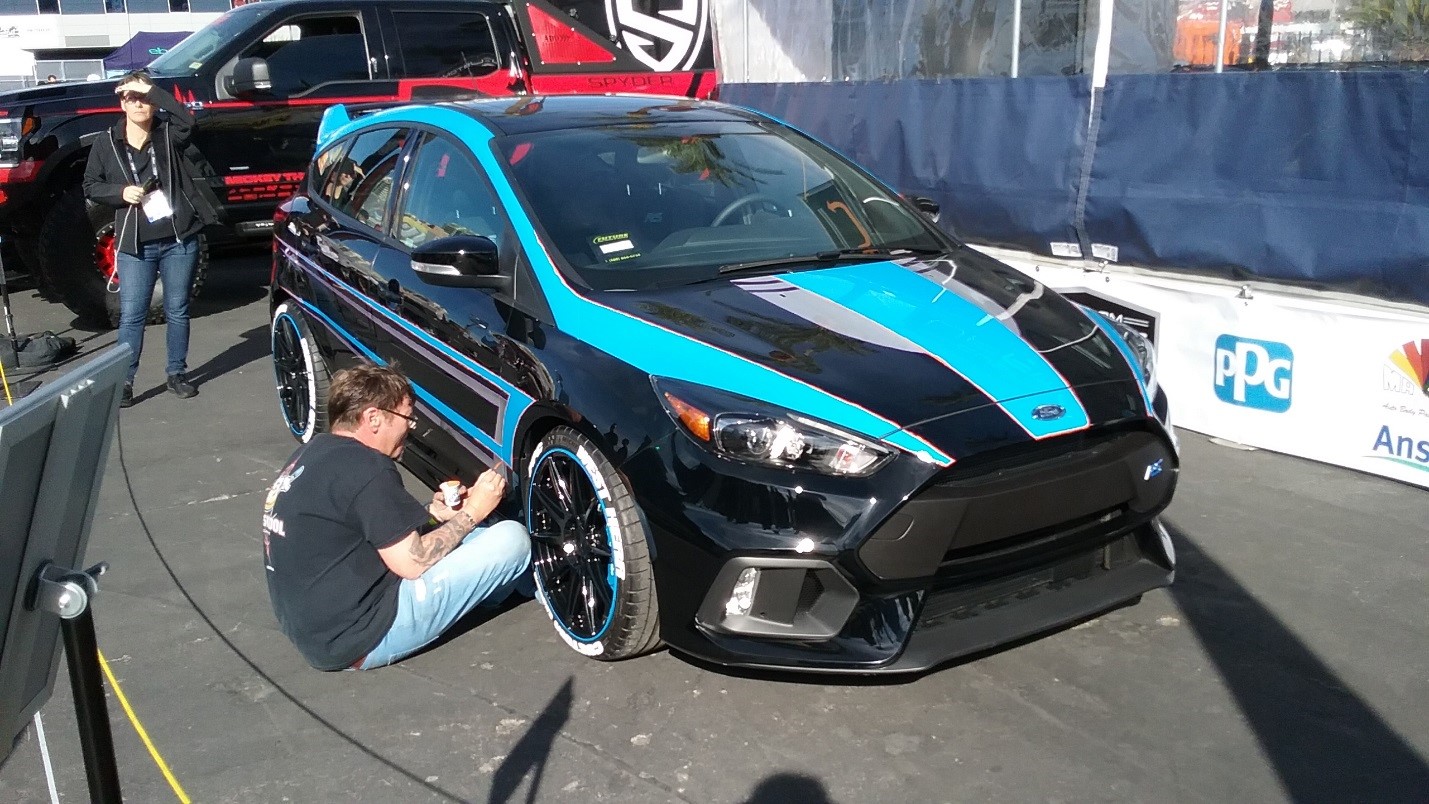 Many SEMA booths hosted live demonstrations, like this pinstriper at work on a Ford Focus RS.
Many SEMA booths hosted live demonstrations, like this pinstriper at work on a Ford Focus RS.
There were educational opportunities, too. Workshops and seminars throughout the week ranged from standard business conference fare (“Building a Sustainable Social Media Strategy”) to the decidedly SEMA-specific (“Building the Best Boosted Engines of Your Career”). If seminars aren’t your thing, you could learn by watching everything from welding to pinstriping taking place right at exhibitor booths.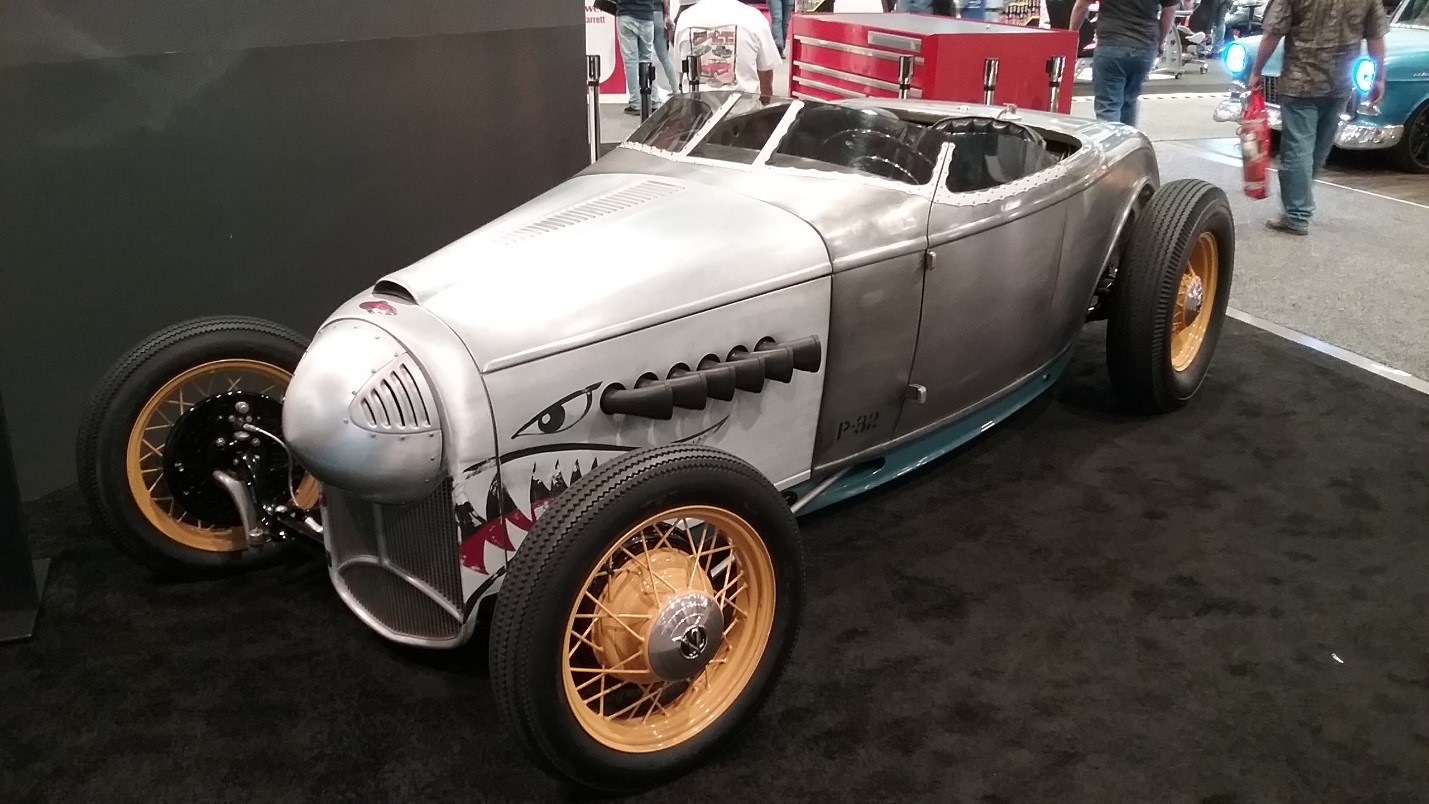 When is a Mustang a Lincoln? When it’s this P-51 Mustang airplane-inspired hot rod by Chip Foose, powered by a Lincoln-Zephyr V-12.
When is a Mustang a Lincoln? When it’s this P-51 Mustang airplane-inspired hot rod by Chip Foose, powered by a Lincoln-Zephyr V-12.
Contests added to the fun, too. Hot Rodders of Tomorrow, a nonprofit that encourages young people to consider careers in the automotive aftermarket industry, sponsored a challenge in which high school teams competed against each other in timed engine rebuilds. The most celebrated contest was SEMA’s annual Battle of the Builders. Nearly 200 customizers brought vehicles to be judged in four categories: hot rods, trucks/off-road vehicles, sport compacts, and young guns (for builders age 27 and under). Three top finishes were selected from each category over the show’s run, and these top 12 vehicles led the post-show SEMA cruise. An overall winner was then selected from the 12. Troy Trepanier took this year’s top prize with his 1929 Ford Model A hot rod.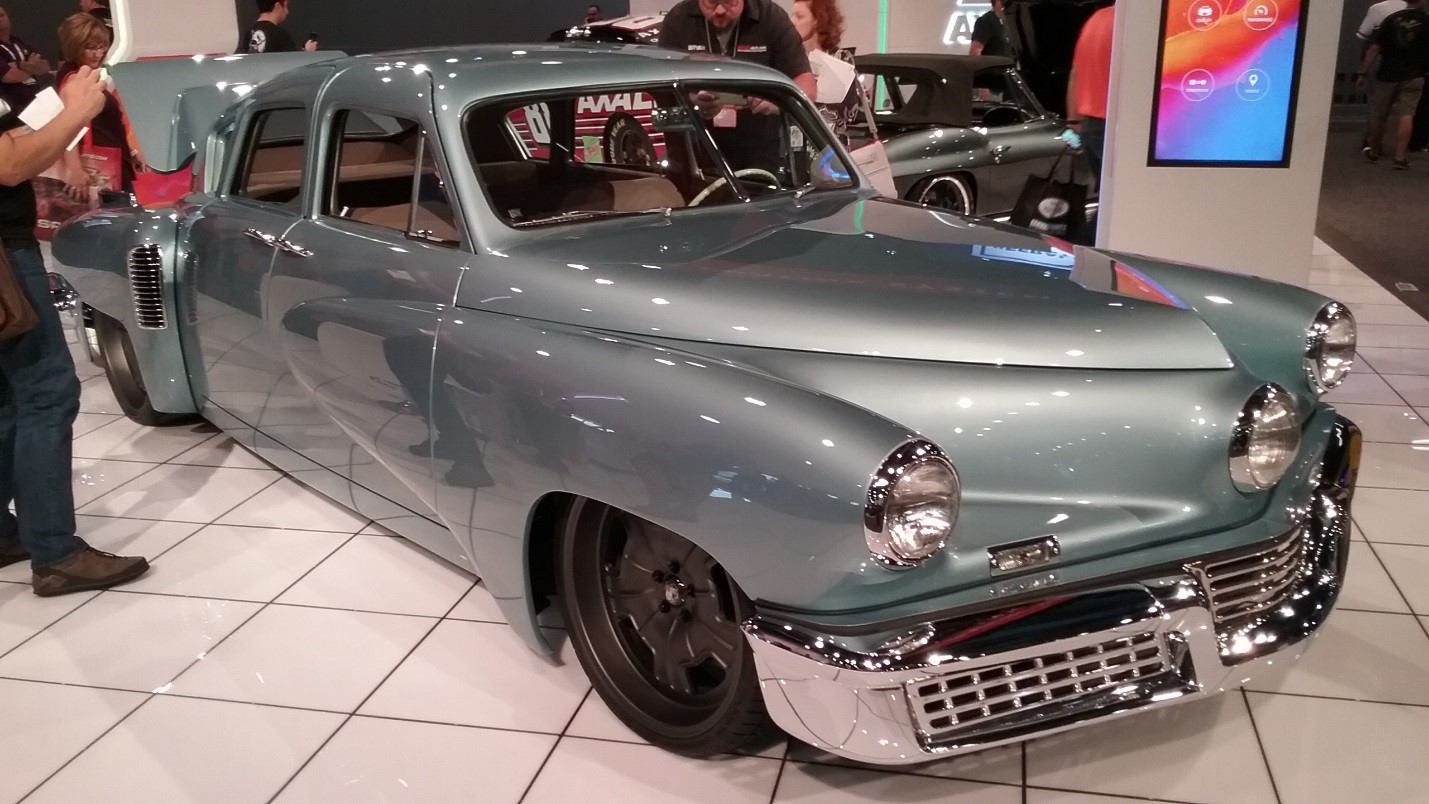 Tucker Tribute: A hand-built replica powered by a Cadillac Northstar V-8.
Tucker Tribute: A hand-built replica powered by a Cadillac Northstar V-8.
So ended another SEMA Show – and a successful golden anniversary tour for the Mark IV. And while it’s good to have the car back in the museum, we’re glad we could share it with so many people over the past two years. We’ll hope to see some of you again in 2067!
Matt Anderson is Curator of Transportation at The Henry Ford.
Europe, 21st century, 2010s, racing, Le Mans, Henry Ford Museum, Driven to Win, events, 1960s, 20th century, race cars, Mark IV, cars, car shows, by Matt Anderson
An Old Car Festival for the Books: 2017
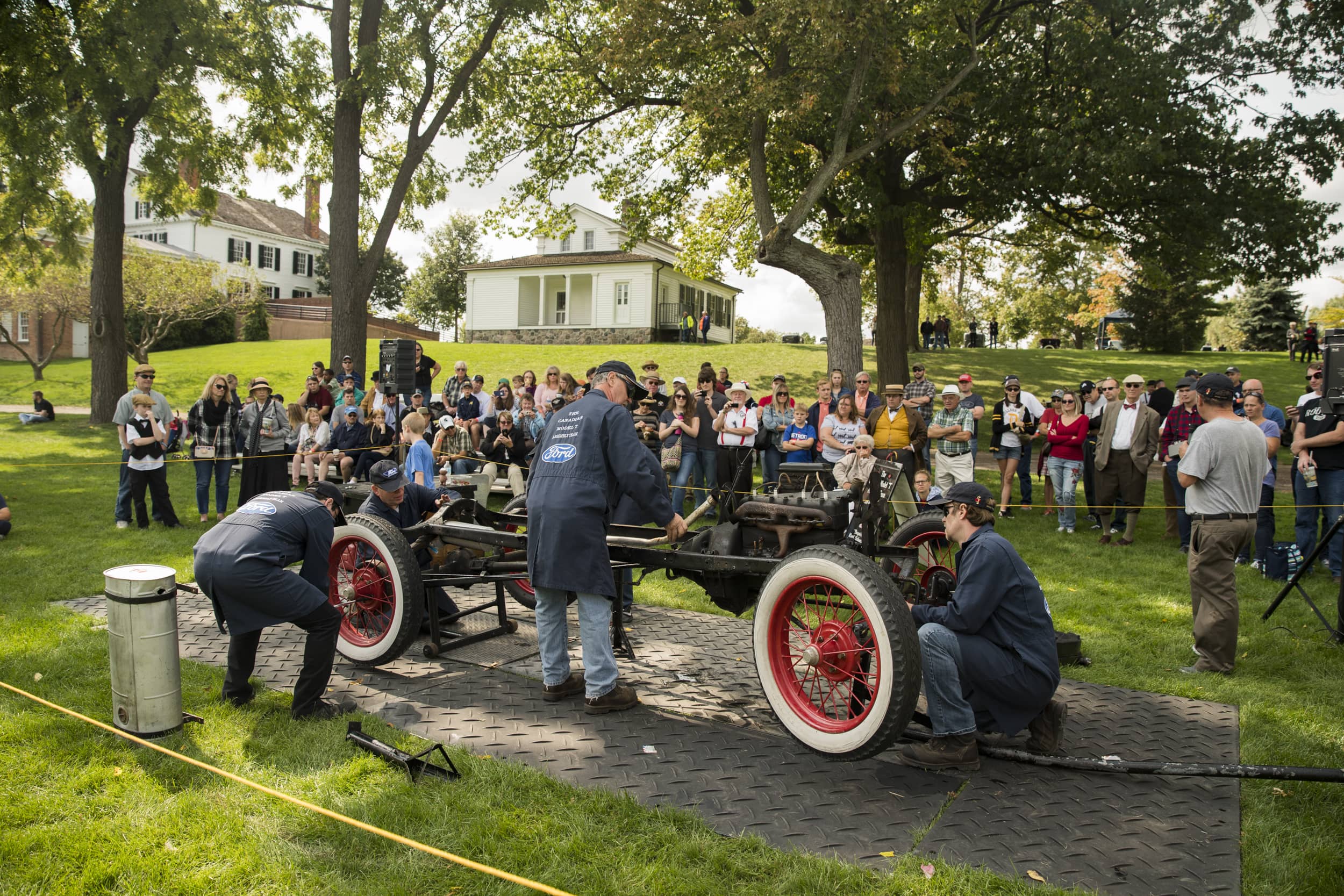
The Canadian Model T Assembly Team wowed Old Car Festival crowds by putting together a working chassis in less than 10 minutes.
Our 67th annual Old Car Festival is in the books – and it was one for the books this year. Postcard-perfect weather, a host of new activities and hundreds of vintage automobiles from motoring’s first decades made this one of the most exciting Greenfield Village car shows in recent memory.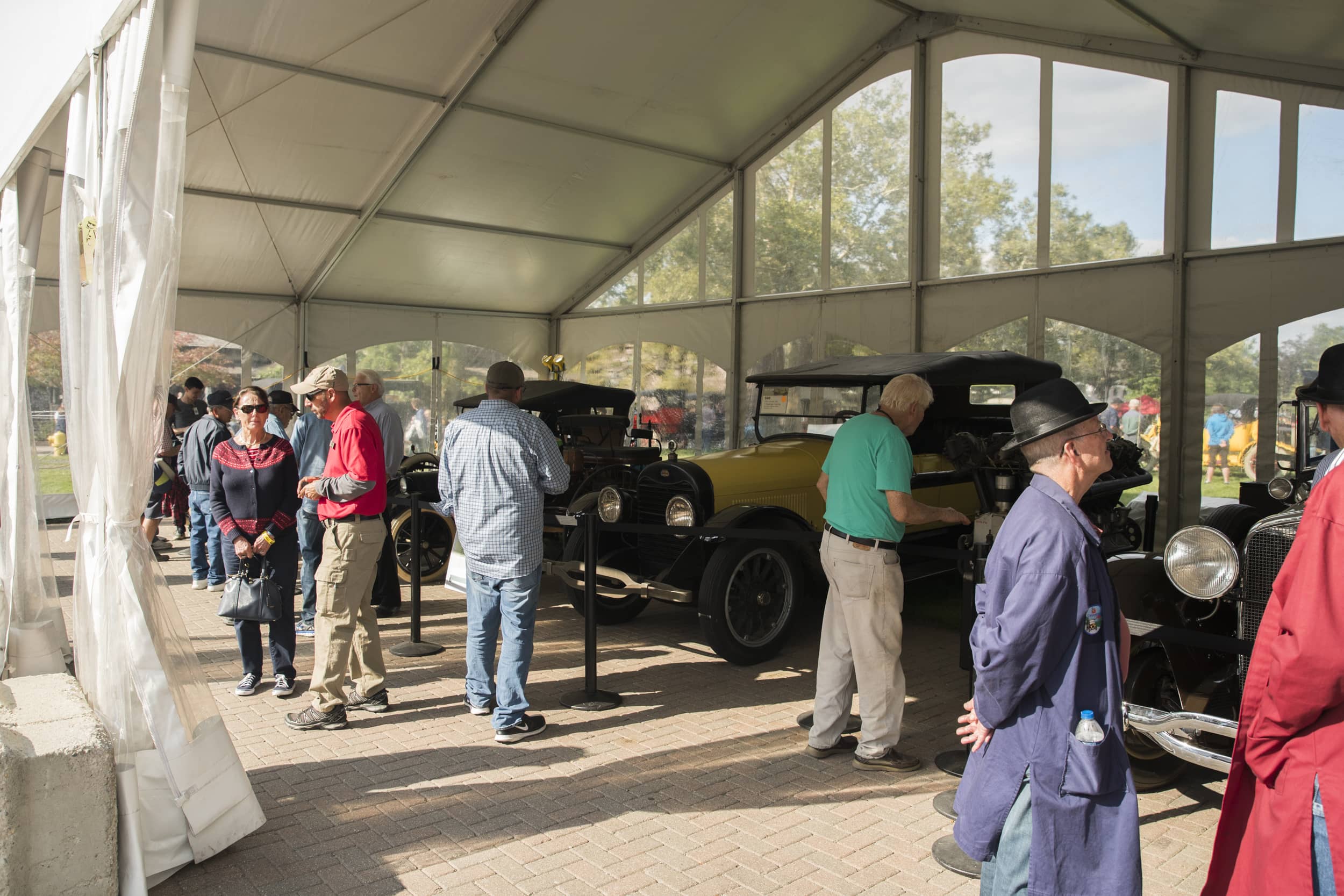 This yellow 1921 Lincoln, from the Cleveland History Center, is believed to be the earliest surviving Lincoln motor car.
This yellow 1921 Lincoln, from the Cleveland History Center, is believed to be the earliest surviving Lincoln motor car.
Lincoln took center stage as our featured marque. It was 100 years ago that Henry Leland left Cadillac to form what would become his second automobile company, named for the first president for whom he voted. We had a number of important Lincolns on hand. From The Henry Ford’s own collection was the circa 1917 Liberty V-12 aircraft engine (Lincoln’s first product) and the 1929 Dietrich-bodied convertible. Our friends at the Cleveland History Center’s Crawford Auto-Aviation Collection brought something very special: a 1921 Model 101 believed to be the oldest surviving Lincoln automobile.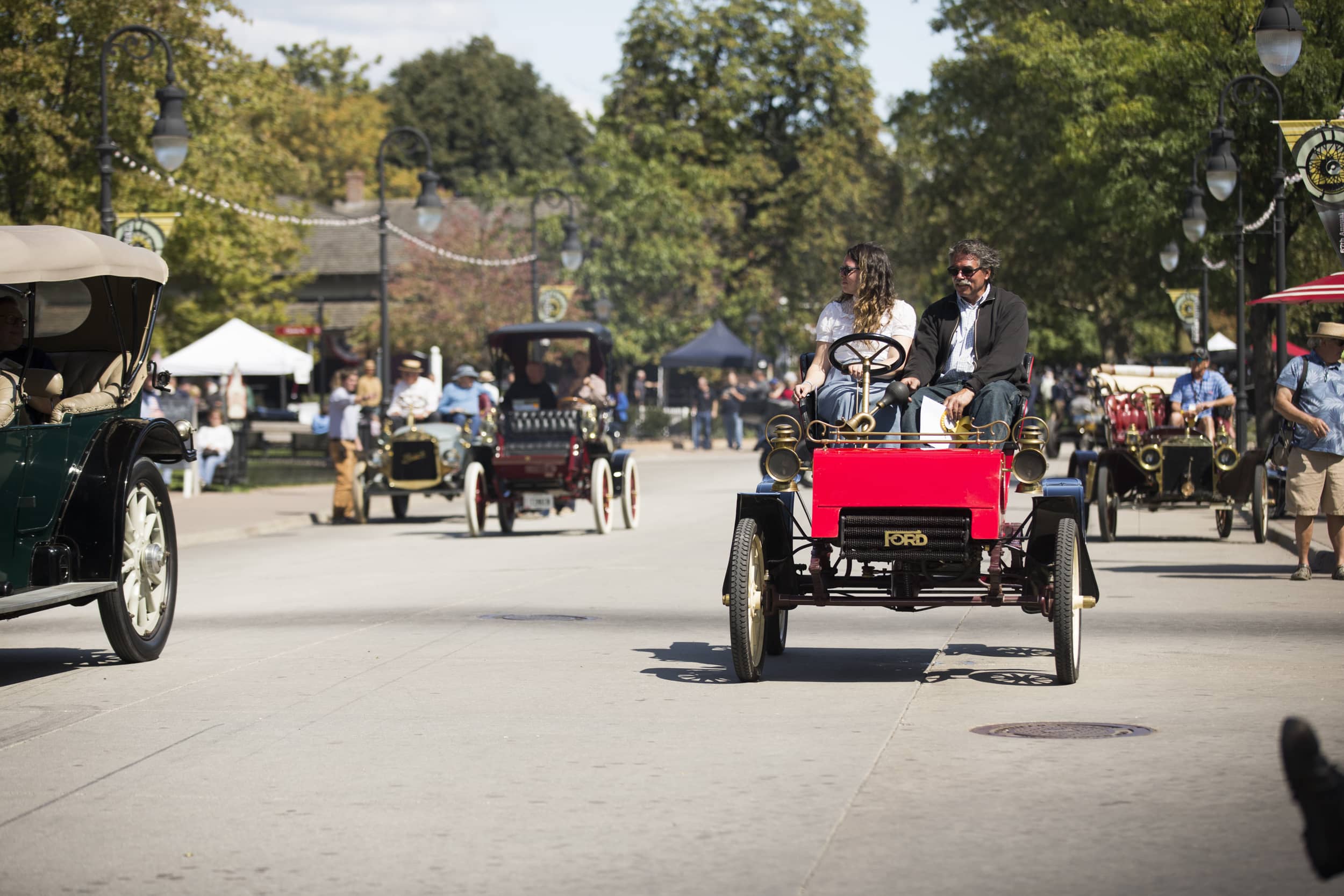 The earliest cars, like this red 1903 Ford Model A runabout, line up for their turn at Pass-in-Review.
The earliest cars, like this red 1903 Ford Model A runabout, line up for their turn at Pass-in-Review.
Automotive enthusiasts had their pick of activities. There were the cars, of course, spread chronologically throughout the village. There were the Pass-in-Review parades, in which our expert narrators commented on participating vehicles as they drove past the Main Street grandstand. There were the car games, and continuing demonstrations by the Canadian Model T Assembly Team, in Walnut Grove. There were bicycle games near (appropriately enough) Wright Cycle Company. And there were presentations on various auto-related topics in Martha Mary Chapel and the Village Pavilion. Old Car Festival welcomed a few genuinely rare cars in addition to the wonderfully ubiquitous (Ford, Chevrolet, Dodge Brothers) and downright obscure (Crow, Liberty, Norwalk). Rarities this year included a 1913 Bugatti Type 22 race car (said to be the oldest Bugatti in North America) and a 1914 American Underslung touring car (purportedly the last vehicle produced by the company). Staff presenters and show participants alike dressed in period clothing, adding to the show’s atmosphere.
Staff presenters and show participants alike dressed in period clothing, adding to the show’s atmosphere.
But this year, the cars were only the beginning. Greenfield Village hosted activities and historical “vignettes” keyed to each decade represented in the show. Aging Civil War veterans reminisced about Shiloh and Gettysburg at the Grand Army of the Republic encampment. Farther into the village, doughboys and nurses commemorated the centennial of America’s entry into the Great War. Sheiks and Shebas danced the Charleston at the bandstand near Ackley Covered Bridge. Southern blues resonated through the Mattox Home, evocative of the Great Depression’s bleakest years. Perhaps the most popular vignette, though, was the 1910s Ragtime Street Fair occupying the southern end of Washington Boulevard. Great food, games and dancing filled the street, all set to music provided by some of the most talented piano syncopators this side of Scott Joplin.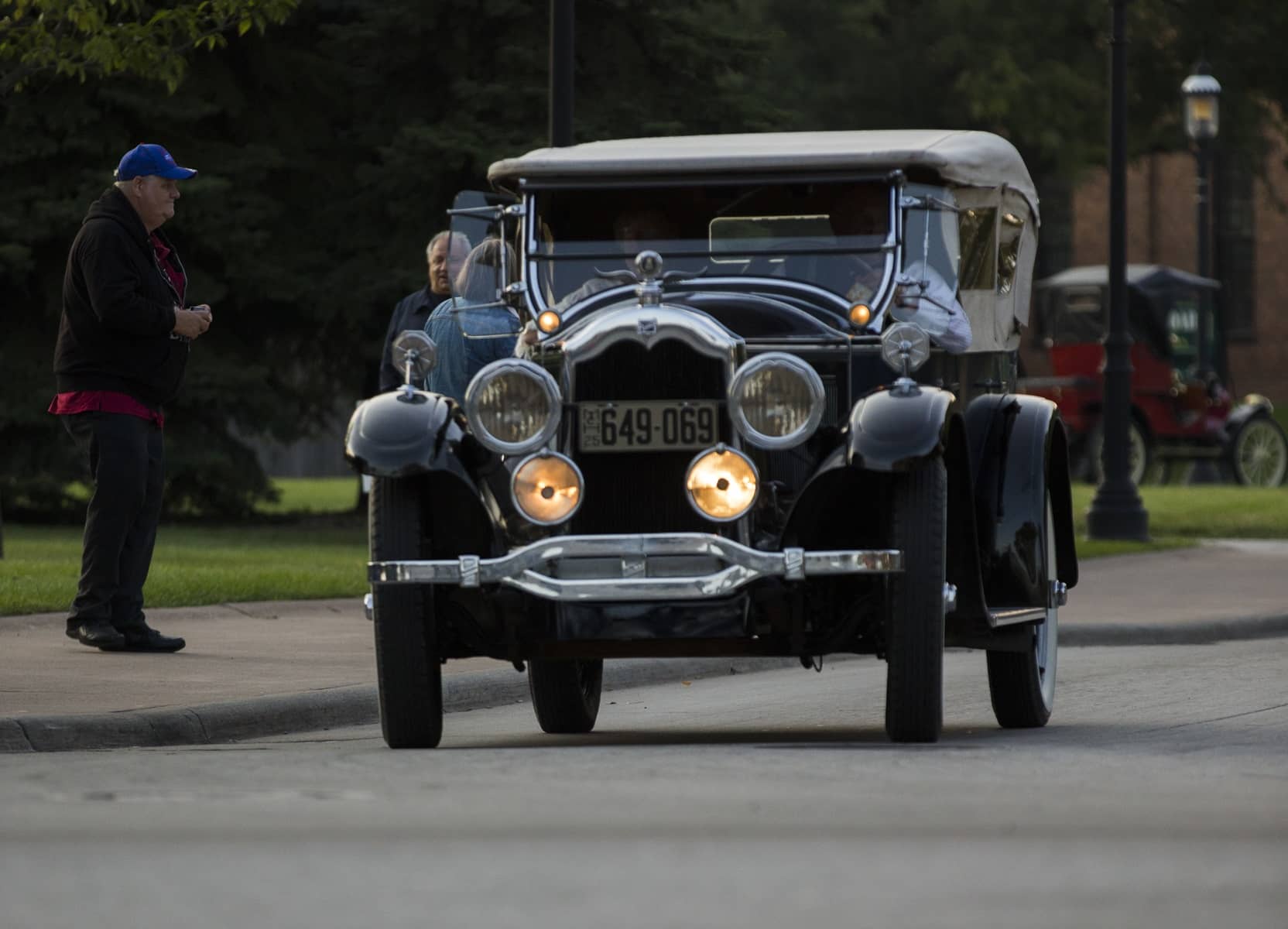 It’s magical when the sun sets and the headlamps turn on, like those on this 1925 Buick Master 6 Touring.
It’s magical when the sun sets and the headlamps turn on, like those on this 1925 Buick Master 6 Touring.
Longtime show participants and visitors will tell you that the highlight comes on Saturday evening. As the sun sets in the late-summer sky, drivers switch on (or fire up) their acetylene, kerosene and electric headlamps for the Gaslight Tour through Greenfield Village. Watching the parade, it’s hard to tell who enjoys it more – the drivers and passengers, or the visitors lined up along the route. This year’s tour was capped by a fireworks display at the end of the night.
It was a special weekend with beautiful automobiles, wonderful entertainment and – most of all – fellowship and fun for those of us who love old cars. Congratulations to the 2017 Old Car Festival Award Winners.
Matt Anderson is Curator of Transportation at The Henry Ford.
Michigan, Dearborn, 21st century, 2010s, Old Car Festival, Greenfield Village, events, cars, car shows, by Matt Anderson
A Feather Duster for Your Flivver
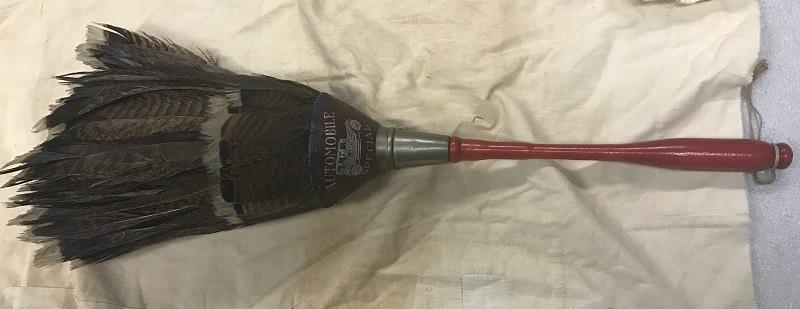
Many of us like to keep our cars clean. Whether it’s with a trip through the automatic car wash, or a hosing and waxing in the driveway, we try to keep the mud, dirt and grime away. Some of us spend just as much time on the interiors, crawling over seats with a shop vac in hand. A car is a big investment and, the more expensive something is, the better care we’re likely to give it.
An automobile was no less an investment a century ago. Even at its absolute lowest price of $260 in 1924, a Ford Model T cost one-fifth of the average annual wage in the United States. Not surprisingly, many car owners took great pains to keep their cars neat and tidy – both to ensure that the vehicle remained in top condition, and as a more basic point of pride. We recently acquired one of the key tools for a fastidious flivver owner – an “Automobile Special” feather duster from the 1920s.
A look at period mail-order catalogs reveals any number of cleaning products available to motorists in the 1910s and 1920s. Montgomery Ward’s 1916 supplemental automobile equipment catalog grouped its cleaning products under the breezy heading, “A Clean Auto Means a More Attractive Auto.” Its pages include a mix of waxes and polishes easily recognizable today, along with archaic products like “Neats Foot Oil Clutch Compound” (used to soften a leather-surfaced clutch that engaged too abruptly). The mail-order giant’s larger Catalog and Buyer’s Guide No. 93 from 1920 devotes most of page 894 to car cleaning. Ward’s offered waxes, enamels, rubber floor mats, horsehair washing brushes, and renewing compounds for leather roofs. The duster advertised on that page is captioned with a helpful – and persuasive – warning: “Do not let dust remain on the finish of your car as it quickly works its way into the paint which kills the luster.”
On that note, our “Automobile Special” duster likely wasn’t recommended for exterior surfaces. Those ten-inch turkey feathers – with their tendency to scratch – would scare off any discerning car owner, then or now. The choosy motorist would have selected a “dustless duster” with chemically-treated fibers designed to absorb dust rather than push it around. They were readily available 100 years ago but, naturally, they came at an extra cost – 35 cents versus 14 cents for a comparable feather duster. Nevertheless, a feather duster could have been safely used to tidy up an auto’s interior surfaces, and many surely were.
While we have other feather dusters in the collection, they likely were intended for use in the home. None is specifically labeled as being for automotive use. This newly-acquired “Automobile Special” duster is an important piece – rough on the paint or not – in that it gets us to the stories of automotive maintenance and pride of ownership in the 1920s, when automobiles were priced within reach of most Americans.
Matt Anderson is Curator of Transportation at The Henry Ford.
Building a Brand… with Buildings
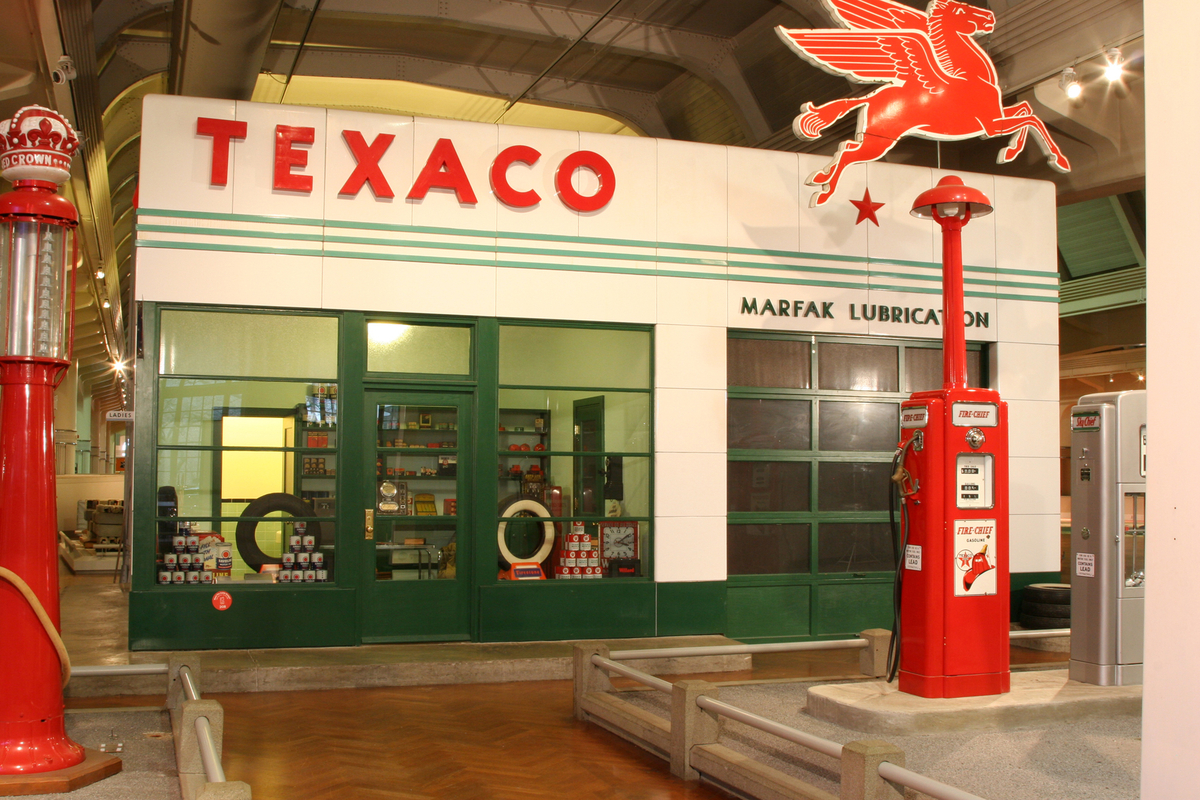
Thanks to Walter Dorwin Teague’s design, Texaco service stations projected a clean, modern and – perhaps most importantly – instantly recognizable image. (From the Collections of The Henry Ford.)
Walter Dorwin Teague’s Texaco Stations
Gasoline is a fiercely competitive business. We’ve all seen intersections with two, three, even four rival gas stations clumped together. Standing out from the crowd is a must. Over the years, retailers developed any number of ways to set themselves apart, including everything from unusual architecture to ultra-clean restrooms. Brand identity – in whatever form it might be – was an essential part of the business.
The Texas Company, better known by the portmanteau Texaco, had its origins in the great Spindletop, Texas, oil strike of 1901, which suddenly had the United States awash in cheap petroleum. Unlike its competitors, which focused on regional markets, Texaco was determined from the start to build itself into a national brand. By 1942, the company had 40,000 outlets spread across the country.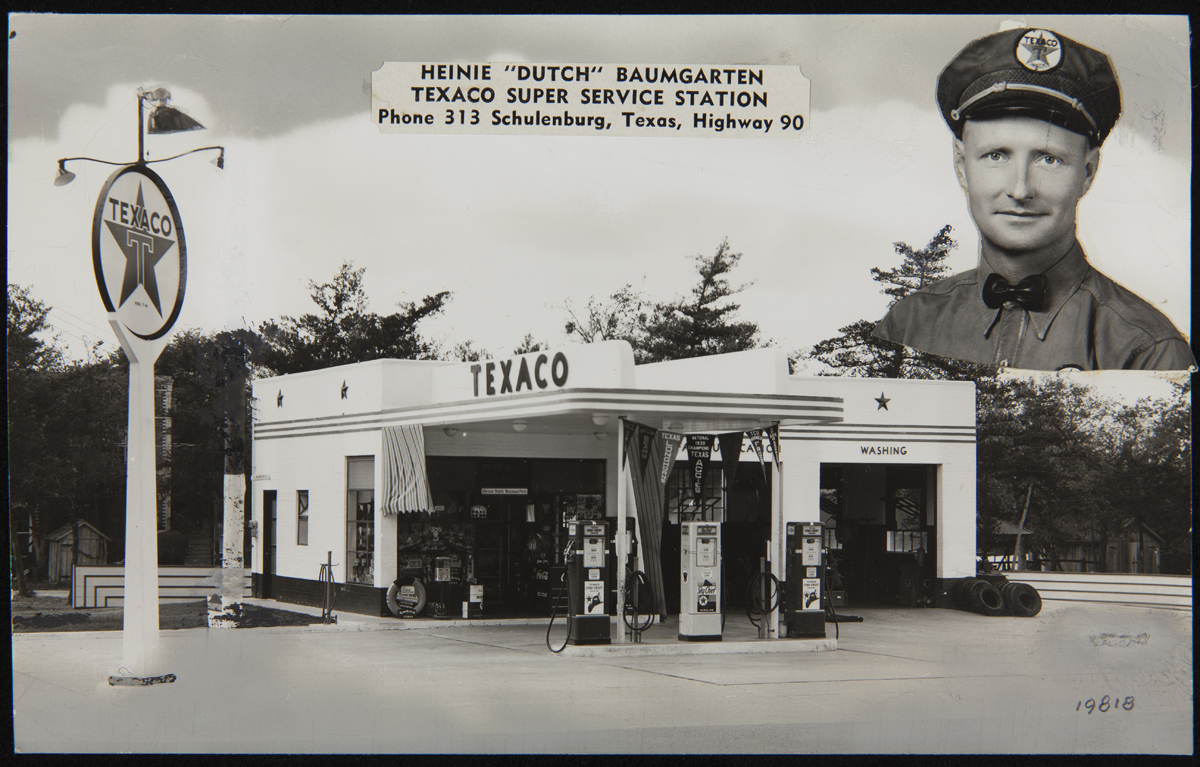
One of Teague’s Texaco stations in use – appropriately enough, in Texas. (John Margolies Roadside America Transparencies. From the Collections of The Henry Ford.)
In 1934, Texaco hired industrial designer Walter Dorwin Teague to create a fresh, unified look for the company’s service stations. Teague came up with a boxlike building covered in white porcelain enamel. Evocative of the then-popular streamlined look, Teague’s design simultaneously suggested speed, modernity and cleanliness. (And, with that porcelain exterior, it was easy to clean.) The gleaming white surface contrasted sharply with its surroundings, wherever the station was located, and readily caught motorists’ eyes. It was easy to illuminate at night, too – a significant benefit for retailers operating around the clock. In time, some 10,000 Teague stations were built across the United States, giving Texaco outlets a consistent appearance and identity.
The basic box building became popular with many of Texaco’s competitors, too. Eminently practical, the design provided space for an office/service counter, automobile service bays, storage, and the all-important restrooms. Furthermore, it could be expanded (or reduced), as business conditions warranted, without harming the building’s overall appearance.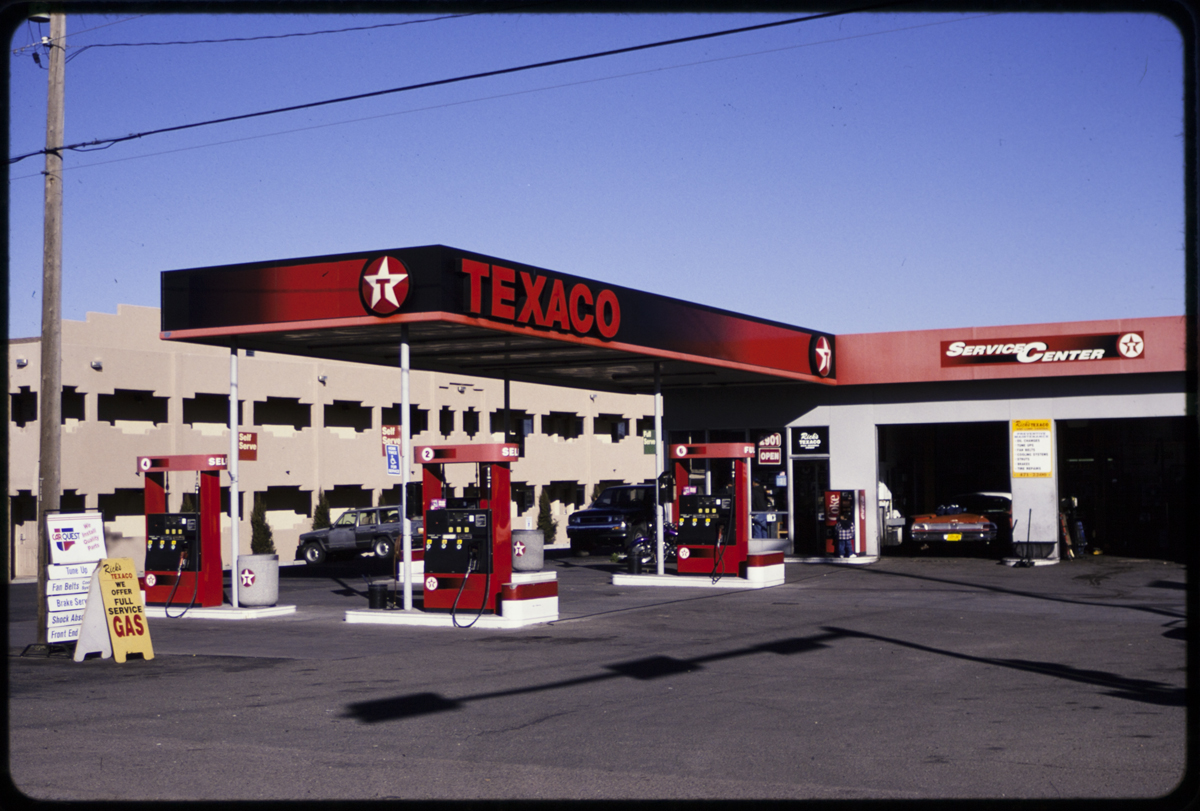
By the 1970s, porcelain enamel was out and darker concrete, brick and wood surfaces were in. (John Margolies Roadside America Transparencies. From the Collections of The Henry Ford.)
But what was fresh and modern in the 1930s was, inevitably, dull and outdated within a few decades. In the 1960s, oil companies began to move away from bright porcelain boxes in favor of more subdued brick facades and gabled roofs. By the 1980s, the box plan itself was superseded by the larger convenience stores we still see today. But Walter Teague’s design lives on in the Driving America exhibit. Our Texaco station was built and operated in Kingston, Massachusetts, before it came to Henry Ford Museum of American Innovation in 1987. The station may not be selling gas anymore, but the its gleaming porcelain still attracts plenty of visitors!
Matt Anderson is Curator of Transportation at The Henry Ford.
Driving America, Henry Ford Museum, roads and road trips, design, by Matt Anderson
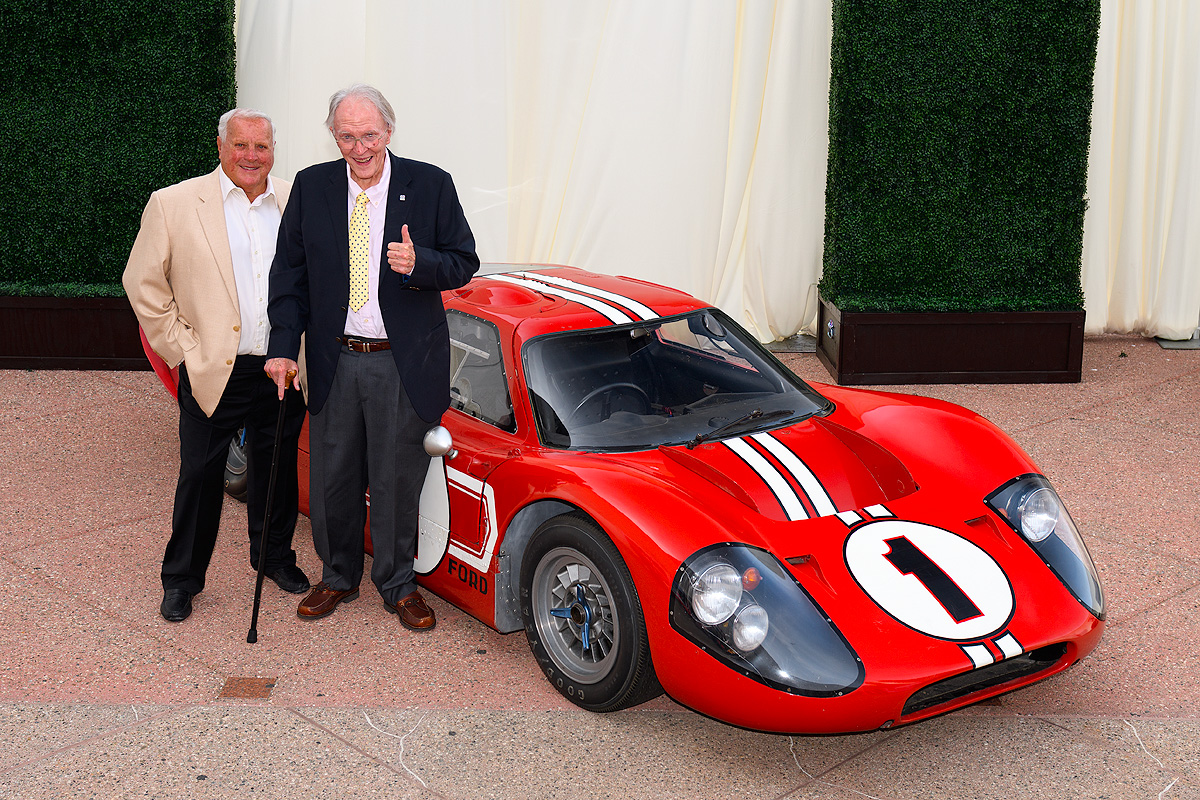
A.J. Foyt and Dan Gurney, reunited with the Ford Mark IV 50 years after their Le Mans triumph. (Courtesy of Ford/Campbell Marketing)
Fifty years ago, on June 11, 1967, Dan Gurney and A.J. Foyt made history by winning the first and – to date – only all-American victory at France’s 24 Hours of Le Mans. For Ford Motor Company and race team Shelby American, it was the second consecutive Le Mans win, following the memorable 1-2-3 finish of 1966. But that first victory came courtesy New Zealander drivers Bruce McLaren and Chris Amon, and the British-built GT40 Mark II. With Californian Gurney and Texan Foyt behind the wheel of the made-in-Dearborn Mark IV, the 1967 win was as American as the proverbial apple pie.
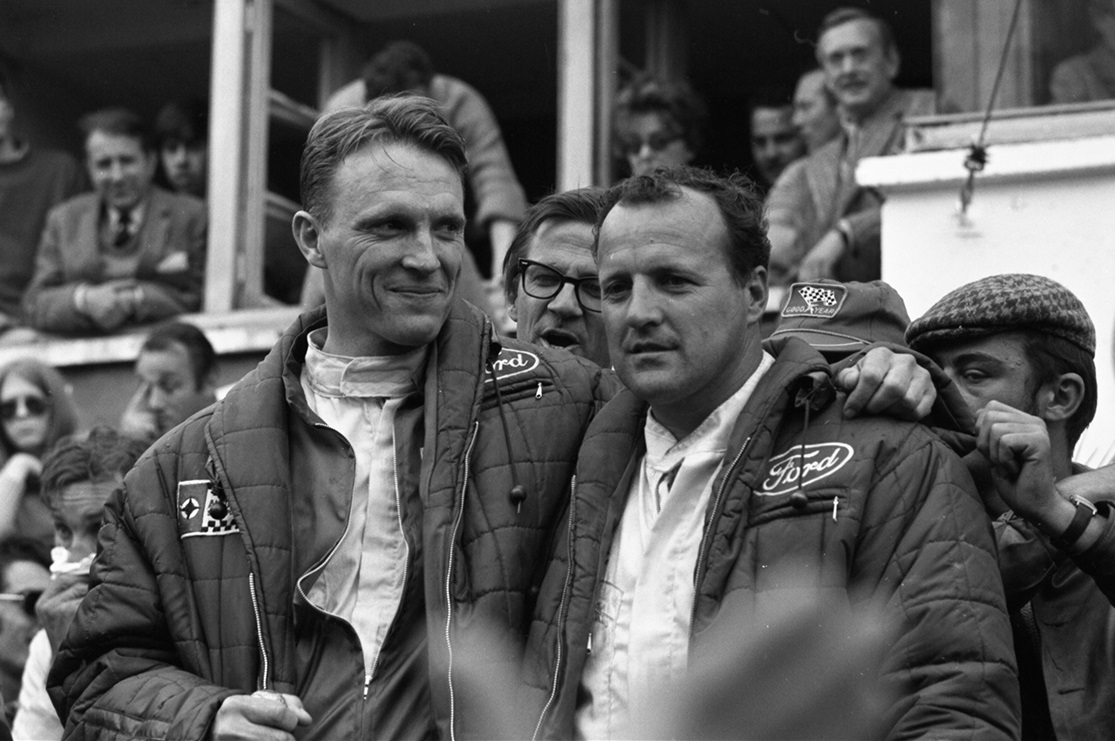
Gurney and Foyt on the Le Mans podium in 1967. (From the Collections of The Henry Ford)
In conjunction with the Toyota Grand Prix of Long Beach, the Road Racing Drivers Club recognized Mr. Gurney, Mr. Foyt and the milestone anniversary in a special ceremony on April 6. The Mark IV left its usual place in Henry Ford Museum of American Innovation and headed west to join the veteran drivers in California, making for a rare reunion of the men and machine that dominated the Circuit de la Sarthe in 1967 and capped the fiery Ford-Ferrari feud. Gurney and Foyt shared their still-vivid memories of the race, reflected on changes in endurance racing over the past five decades, and resoundingly agreed that June 1967 marked a high point in both of their careers. (Just ten days before the ’67 Le Mans, Foyt won his third Indianapolis 500, and a week later, Gurney won the Formula One Belgian Grand Prix in one of his Eagle race cars.)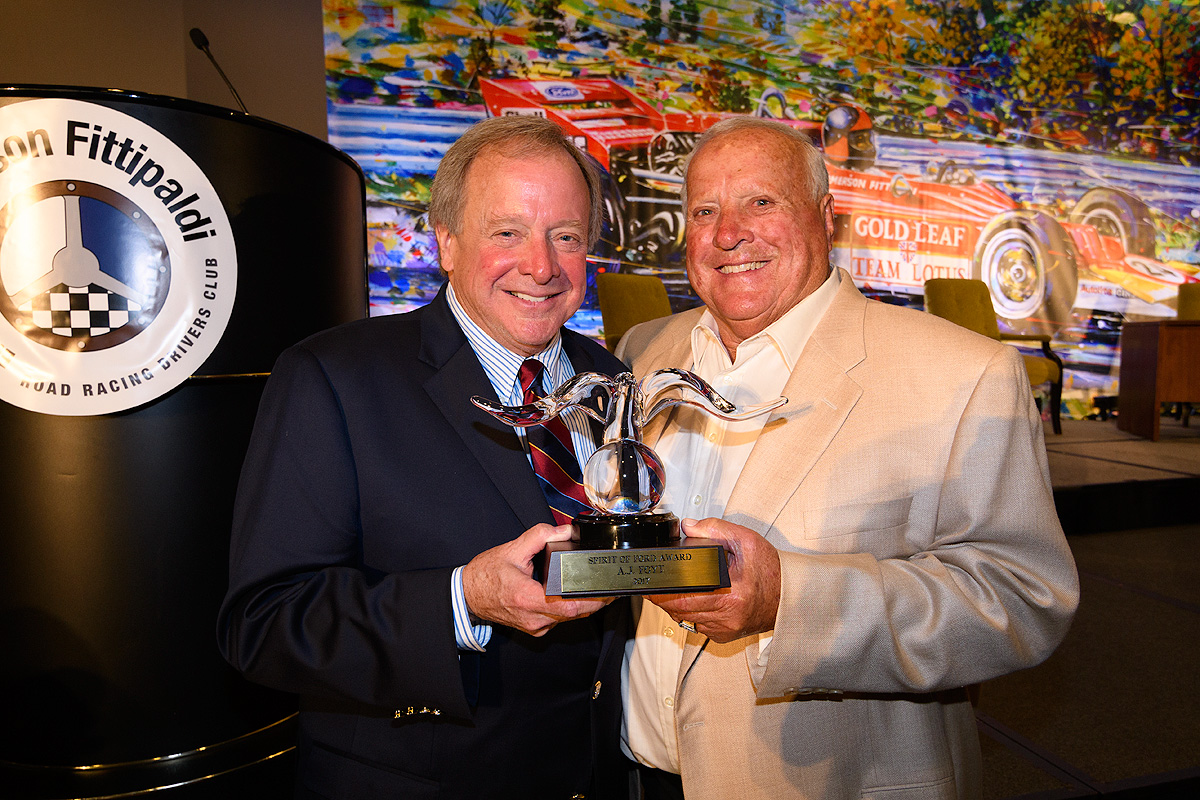
Edsel Ford II presents A.J. Foyt with the Spirit of Ford Award. (Courtesy of Ford/Campbell Marketing)
Mr. Foyt received another tribute before the evening was over. Ford Motor Company director Edsel Ford II presented him with the Spirit of Ford Award, the company’s highest honor in auto racing. Foyt is only the 26th recipient since the prize was established 1988, and he joins a prestigious group of past winners like Carroll Shelby, Richard Petty, Denise McCluggage, John Force and Sir Jackie Stewart. (Mr. Gurney is a 1999 Spirit of Ford recipient.)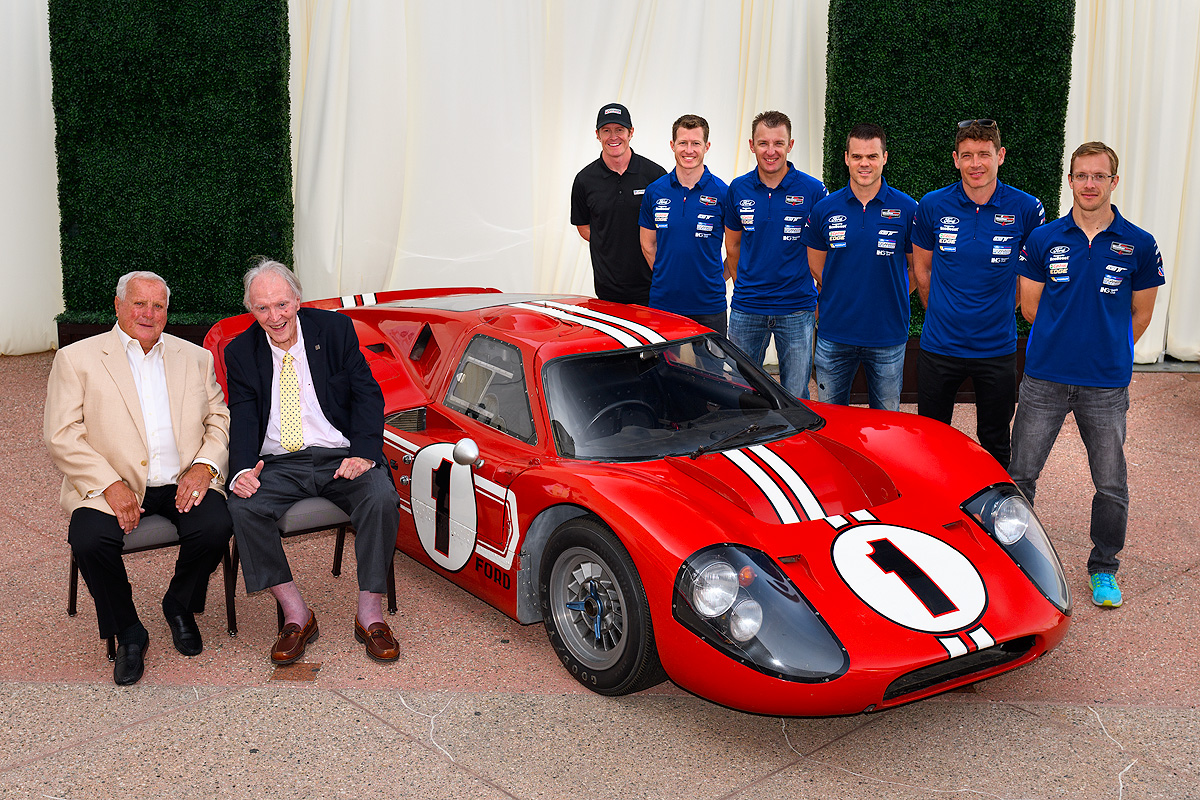
Foyt and Gurney joined by a new generation of Ford GT drivers (L to R: Scott Dixon, Ryan Briscoe, Joey Hand, Dirk Müller, Richard Westbrook and Sébastien Bourdais). (Courtesy of Ford/Campbell Marketing)
It was an incredible evening, not only because of the chance to reflect on 1967, but also due to the excitement building toward this year’s 24 Hours of Le Mans, where Ford will look to defend its 2016 class victory with the current Ford GT. Two of Ford’s 2016 driver teams, Joey Hand, Dirk Müller and Sébastien Bourdais; and Ryan Briscoe, Richard Westbrook and Scott Dixon, were on hand in Long Beach. Past and present came together when the “kids” joined Foyt and Gurney for a group photo with the Mark IV. Fifty years later, A.J. Foyt and Dan Gurney continue to inspire – on the track and off.
Matt Anderson is Curator of Transportation at The Henry Ford.
race cars, race car drivers, racing, by Matt Anderson, Henry Ford Museum, Driven to Win
Ford Ambulances for the Red Cross
Ford Motor Company devoted its employees and manufacturing facilities to military production during both of the 20th century’s world wars. Ford’s efforts in World War I were slow to start, given Henry Ford’s outspoken opposition to the conflict, but once the United States declared war on Germany in April 1917, the automaker rose to the challenge. Over the next two years, Ford built passenger cars, supply trucks, aircraft engines, gun caissons, tanks, helmets and body armor. Ironically, one of Ford’s best-known wartime products, the Eagle anti-submarine boats, never saw action before the Armistice. However, the factory that built the Eagle boats subsequently became the core of Ford’s River Rouge plant.
Ford’s efforts for World War II were greater still. Like other American automakers, the company suspended all civilian production in February 1942. Ford famously turned out B-24 bombers at its Willow Run facility, but it also produced a variety of wheeled vehicles including jeeps, amphibious cars, armored cars, trucks and tanks. Ford’s non-vehicle production included military gear of every type, from aircraft engines to guns to helmets to tents.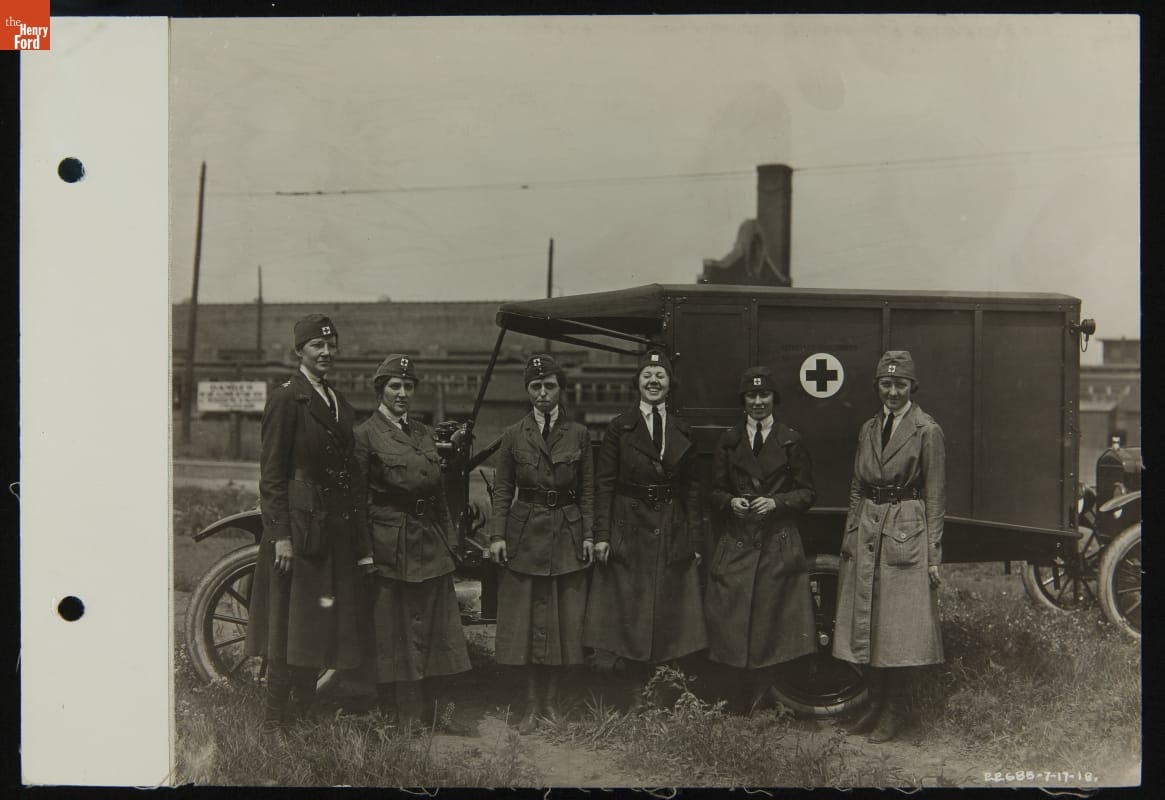
Red Cross Workers with a Ford Military Ambulance at the Highland Park Plant, 1918. THF 263442
Needless to say, ambulances were among the most crucial vehicles used in both wars. During World War I, Ford personal collaborated with the United States Surgeon General’s Office and frontline drivers to design a Model T-based ambulance ideal for battlefield conditions. The company donated $500,000 to the Red Cross, enabling the humanitarian organization to purchase nearly 1,000 vehicles for wartime use – including 107 ambulances. Beyond those Red Cross units, another 5,745 ambulances were built for the Allied armies.
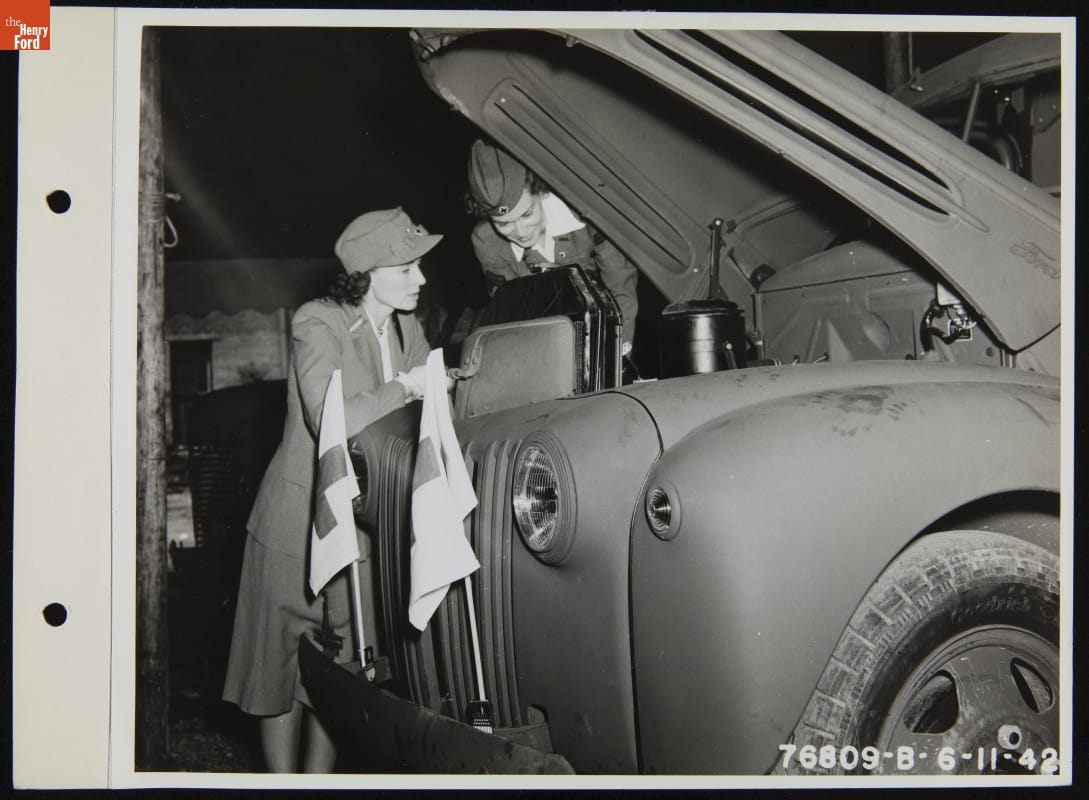
Red Cross Motor Corps members took classes in auto maintenance. These women are checking under a Ford ambulance’s hood in 1942. THF 265816
Dodge produced most of the frontline ambulances used by American forces in World War II, but Ford units were active on the homefront. The Red Cross’s Motor Corps, established in World War I, rendered important service during the Second World War as well. Corps drivers working in the United States ferried Red Cross staff and supplies, couriered packages and messages, and occasionally stepped in to assist with Army and Navy transportation needs. An estimated 45,000 women were active in the Motor Corps during World War II. Corps members generally drove their personnel vehicles in this service, but Ford-built ambulances were also used in the transport of the sick and wounded.
In honor of National Red Cross Month, take a look at our digital collections to see more artifacts related to the organization.
Matt Anderson is Curator of Transportation at The Henry Ford.
manufacturing, 1940s, 1910s, 20th century, World War II, World War I, healthcare, Ford Motor Company, cars, by Matt Anderson
Detroit Autorama 2017: A Car Show Like No Other
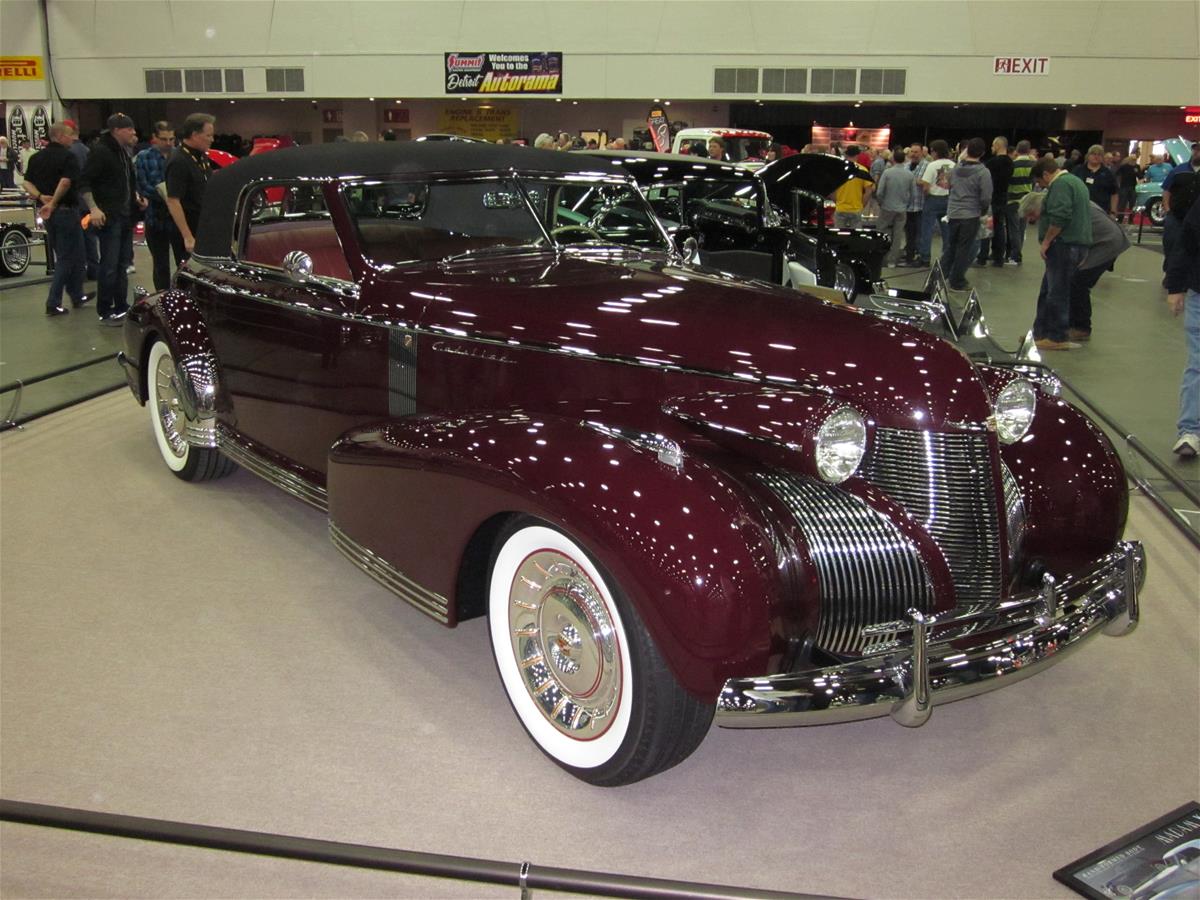
“Madam X,” a 1939 Cadillac Sixty Special and one of the stars of the 2017 Detroit Autorama.
The car show season usually feels far away in late February. (Usually. Maybe not this year, when Detroit temperatures have already approached 70 degrees.) But the weekend of February 24-26 brought us a tease of the top-down, volume-up cruising weather to come. More than 800 cars filled Cobo Center for the 65th annual Detroit Autorama, among the most important shows in the hot rod and custom car hobby.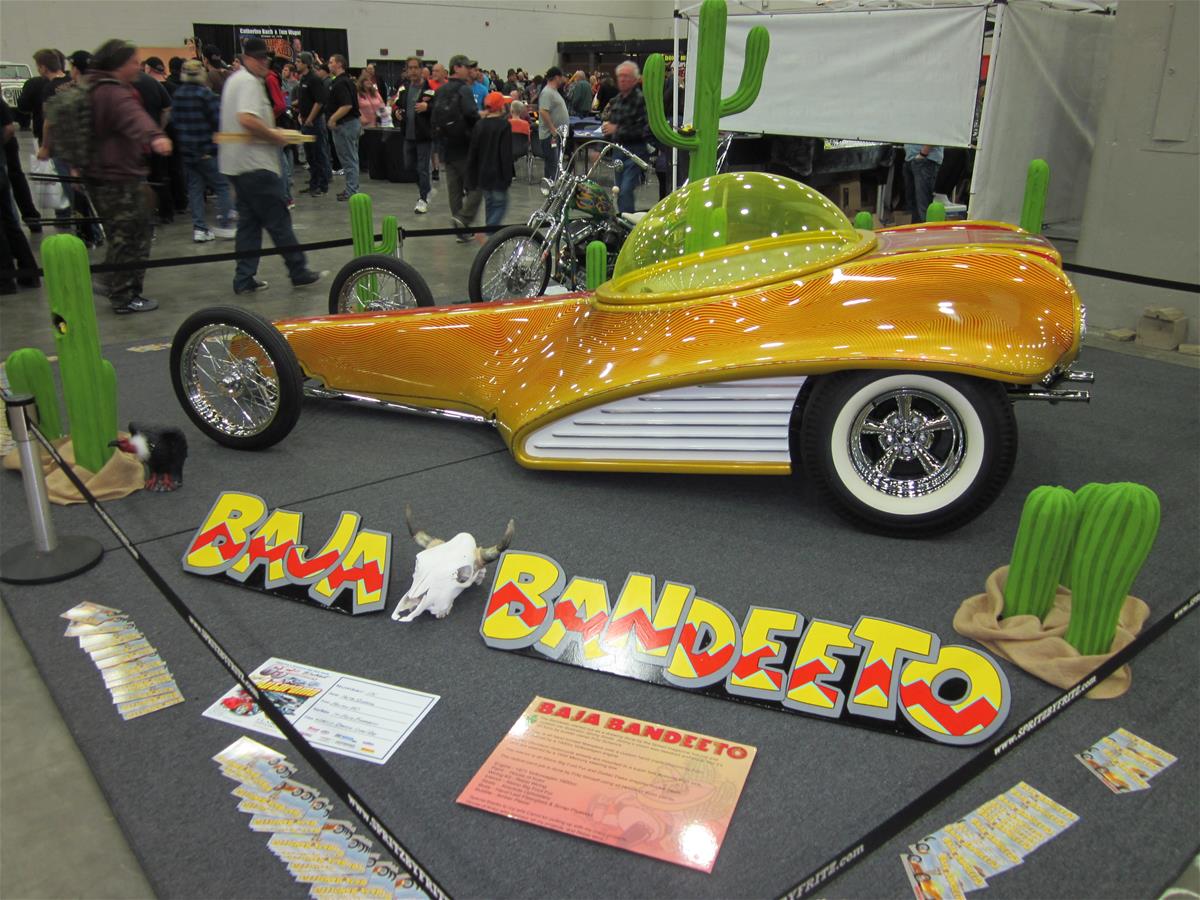 The VW Beetle-based “Baja Bandeeto,” showing that presentation is everything.
The VW Beetle-based “Baja Bandeeto,” showing that presentation is everything.
Naturally, Autorama doesn’t simply open the doors to kick off the event. No, it starts with something special. This year launched with a nod to The Dukes of Hazzard, the downhome television series that undoubtedly influenced every Autorama participant born between 1970 and 1980. The Northeast Ohio Dukes stunt show team patched together a derelict Dodge Charger, gave it the necessary orange paint, and jumped it 134 feet over Atwater Street, just outside Cobo Center. The flight was fantastic, but the landing… well, that Charger needs more care than Cooter Davenport can give it if it’s ever going to fly again.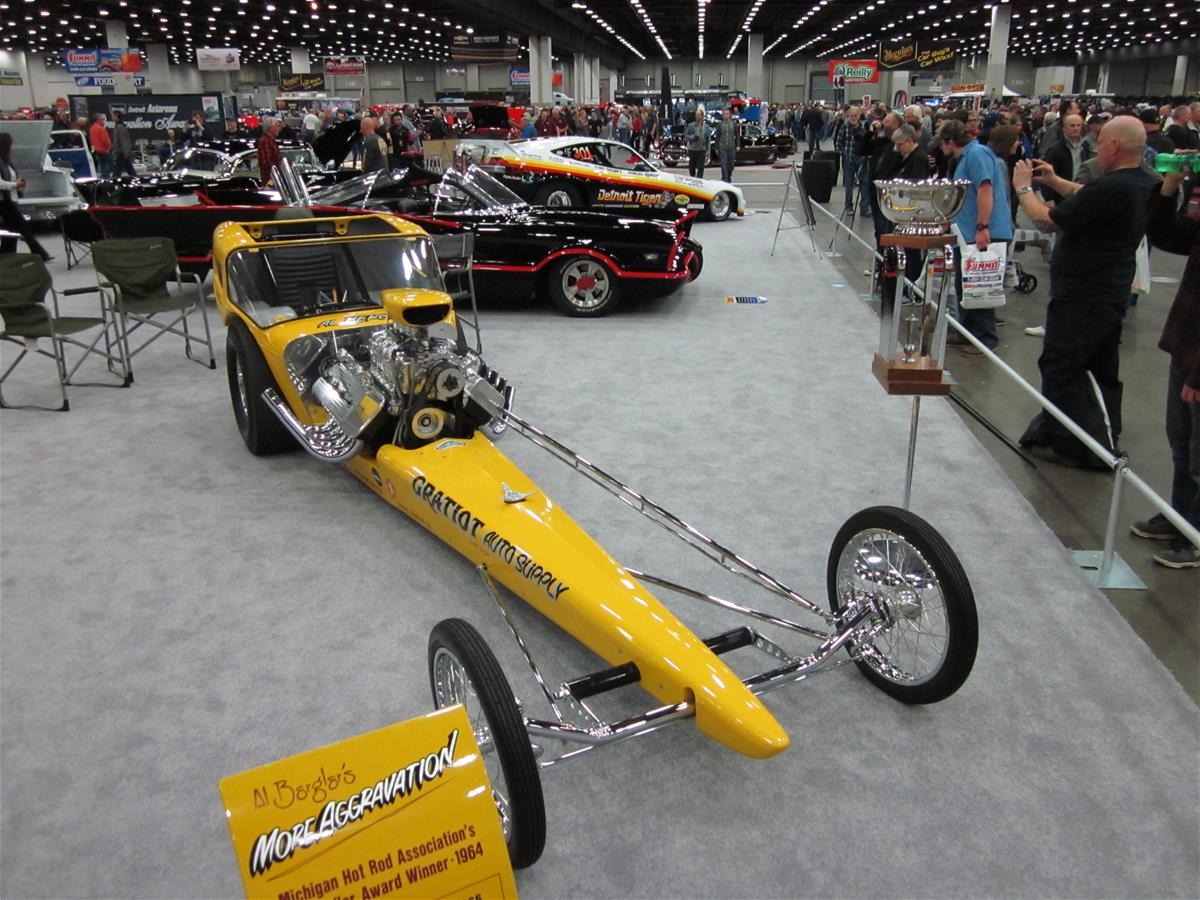 “More Aggravation,” recipient of the very first Ridler Award in 1964.
“More Aggravation,” recipient of the very first Ridler Award in 1964.
Autorama’s top prize is the revered Ridler Award, named for early show promoter Don Ridler. Qualifying cars cannot have been shown publically prior to Autorama. Judges announce their “Great 8” – the eight finalists – at the Ridler’s Ball on Friday night. For the rest of the weekend, anticipation builds until the winner is revealed at the end of Sunday’s awards ceremony. The winning owner earns a small piece of immortality, with her or his name forever engraved on the trophy and added to the Winner Archive, and a not-so-small chunk of change in the form of $10,000. This year’s Ridler Award went to “Renaissance Roadster,” a scratch-built 1933 Ford powered by a GM big-block 427 crate engine.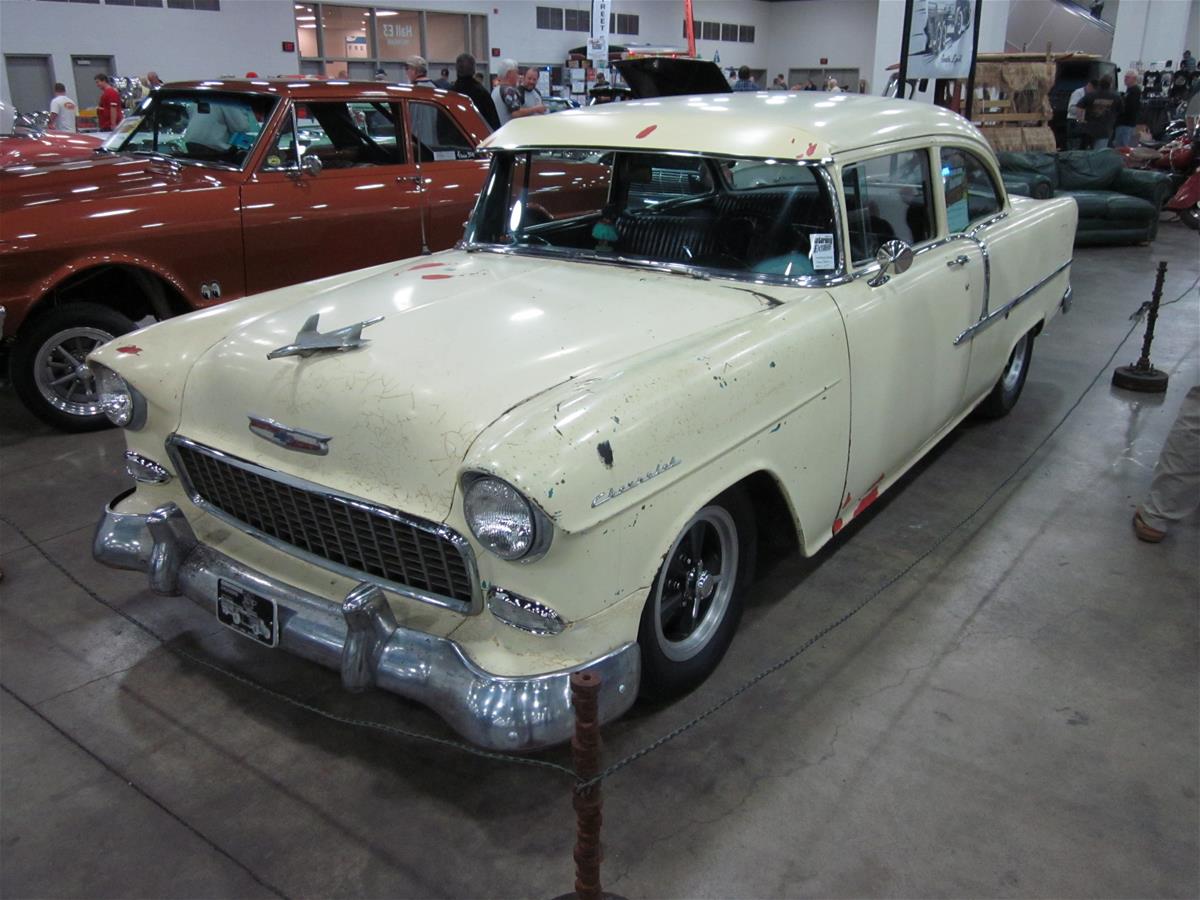 One of the Rat Rods – the deliberately under-restored cars – that populated Autorama Extreme on Cobo Center’s lower level. Even in this condition the ’55 Chevy’s inherent beauty shines through.
One of the Rat Rods – the deliberately under-restored cars – that populated Autorama Extreme on Cobo Center’s lower level. Even in this condition the ’55 Chevy’s inherent beauty shines through.
For the fourth year, The Henry Ford presented its Past Forward award. With the prize, we look to honor a car that 1.) Combines traditional inspirations with modern innovations, 2.) Exhibits a high level of skill in its construction, 3.) Captures the “anything goes” attitude of the hot rod and custom car hobbies, and 4.) Is just plain fun.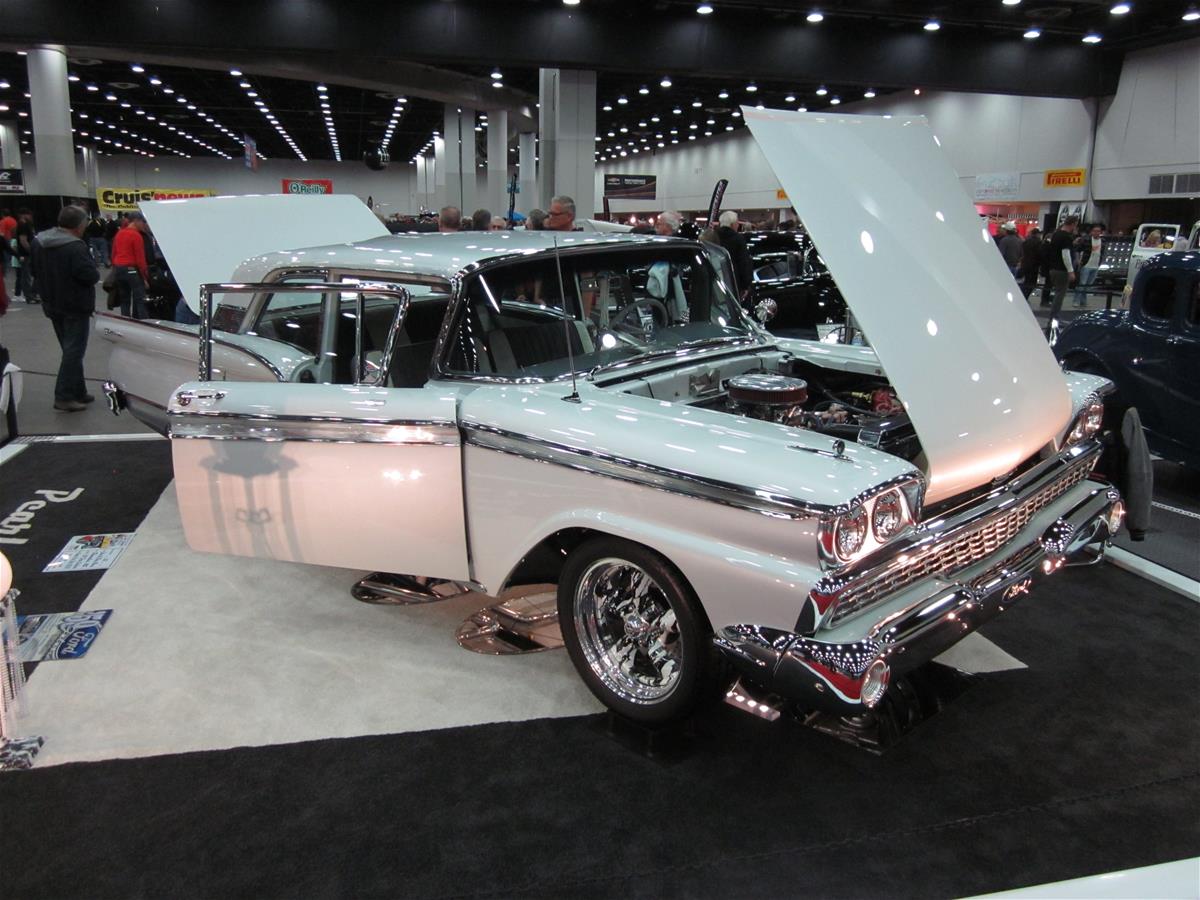 “Pearl Necklace,” winner of The Henry Ford’s Past Forward award for 2017.
“Pearl Necklace,” winner of The Henry Ford’s Past Forward award for 2017.
For 2017, we found all of those qualities in “Pearl Necklace,” a 1959 Ford Galaxie 500 built and owned by John Oberg and Roy Oberg. Apart from the pearlescent paint that inspired its name, and the beautiful marbled wheels (with retro Ford Motor Company logos on the hubs), “Pearl Necklace” could almost pass for stock. But this Galaxie’s a sleeper. The 352 V-8 was bored out by .020 inches, the stock differential was replaced with a 3.73 gearset for faster launches, and the transmission was replaced with Ford’s rugged C6 automatic to handle extra torque. Not that the car was too shabby even when originally built. Plaques on the door proudly boast that it’s “Air Conditioned by Ford Select Aire,” a ritzy option that accounted for almost 20 percent of the original $2,500 sticker price!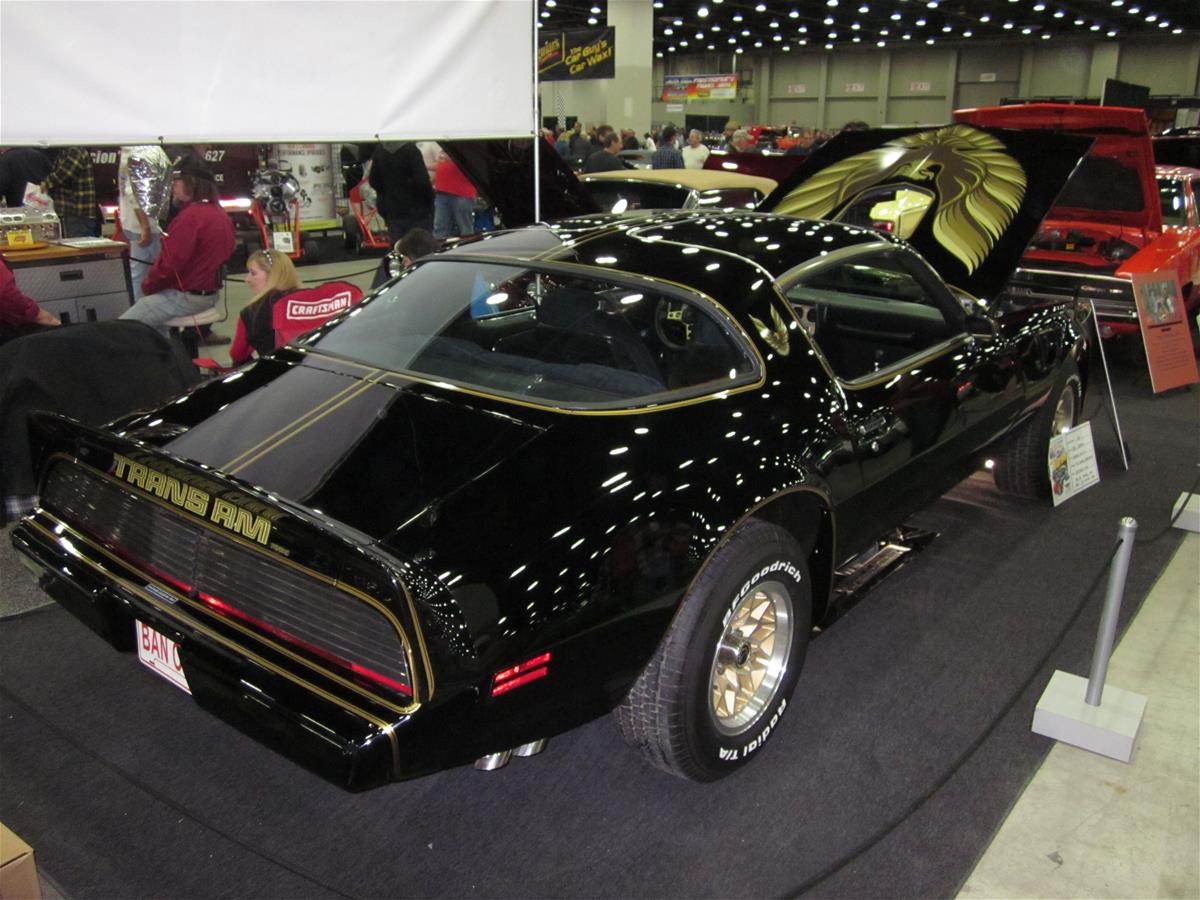 This 1979 Pontiac Firebird Trans Am was pointed west in Cobo Center, but it was eastbound in spirit.
This 1979 Pontiac Firebird Trans Am was pointed west in Cobo Center, but it was eastbound in spirit.
But the best thing about “Pearl Necklace” was simply this: The car was a labor of love, built by John and Roy (with help from one or two friends) in a two-car garage over the course of 26 years. It’s that kind of dedication that makes a custom car special – and makes the Detroit Autorama a car show like no other.
Matt Anderson is Curator of Transportation at The Henry Ford.
21st century, 2010s, Michigan, Detroit, cars, car shows, by Matt Anderson, Autorama
Exposed Engine: 1913 Scripps-Booth Rocket Cyclecar
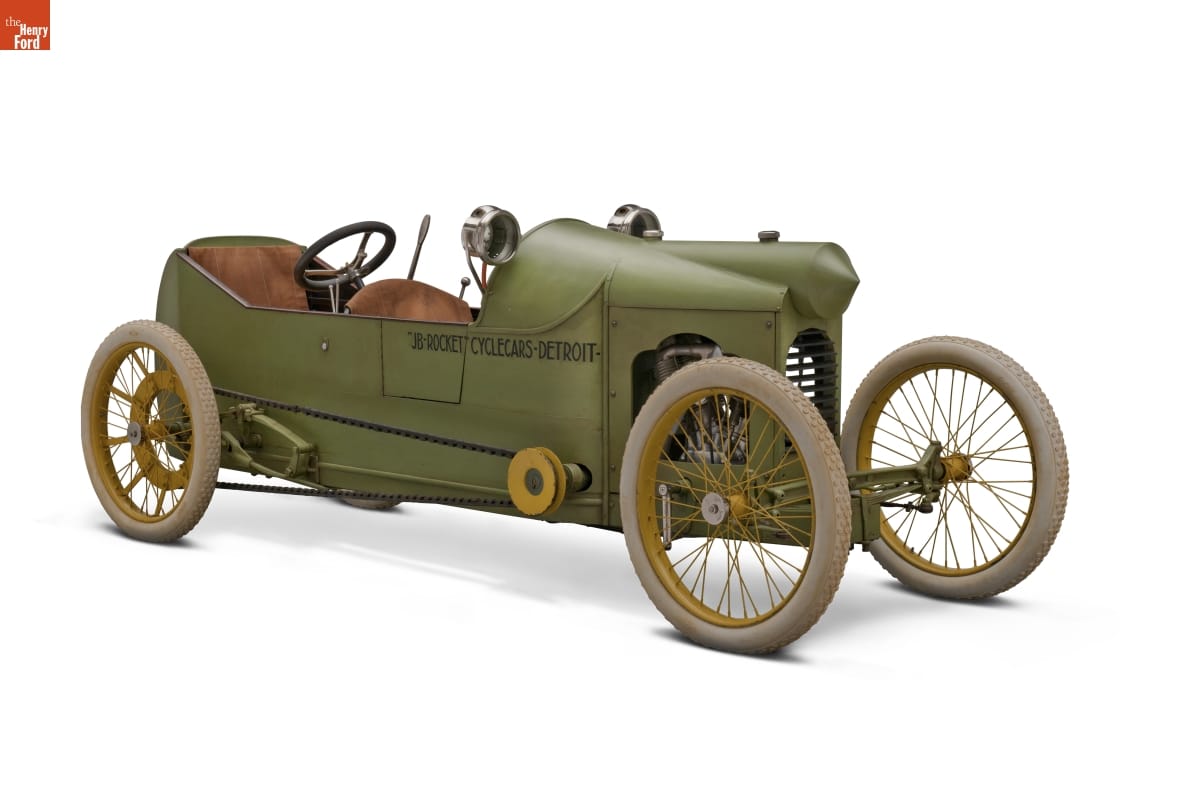
1913 Scripps-Booth Rocket
V-2 cylinder engine, air-cooled, 35 cubic inches displacement, 10 horsepower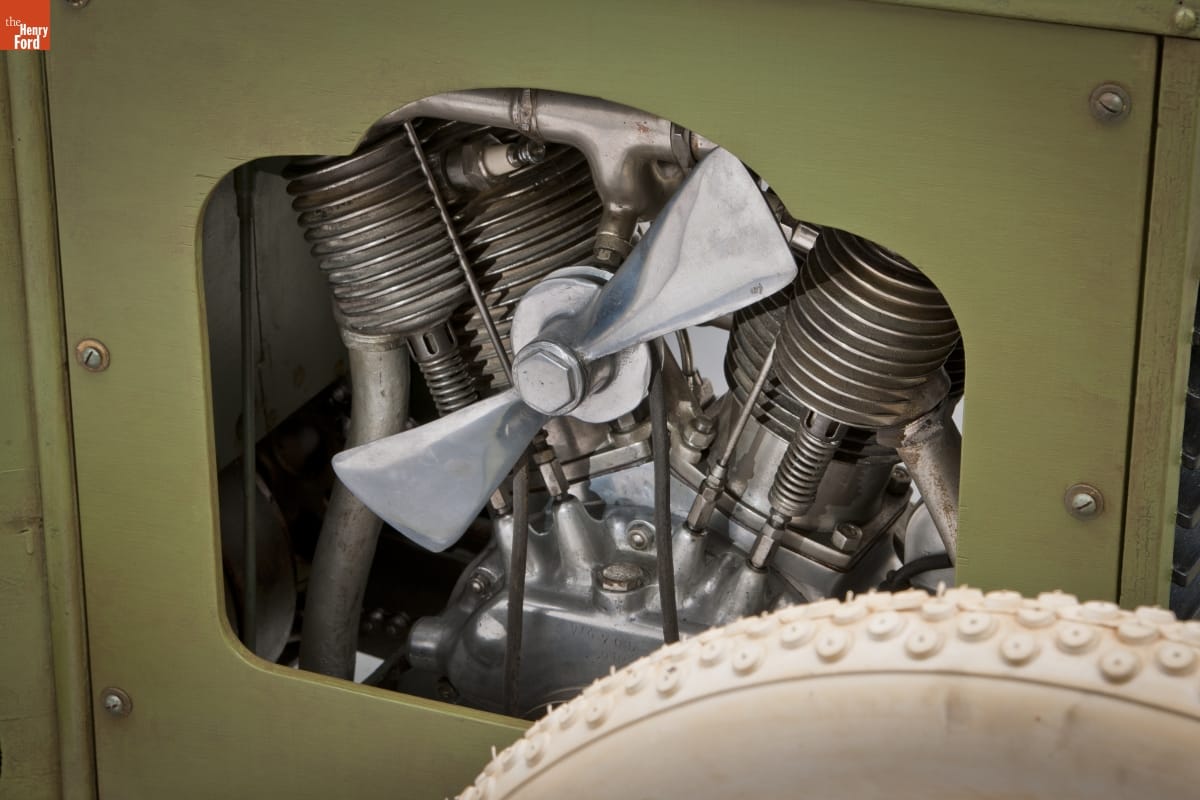
Inexpensive cyclecars, as the name suggests, often used motorcycle engines like the V-2 in this Scripps-Booth prototype. The air-cooled motor meant there was no need for water or a radiator, while the splash lubrication system eliminated the necessity for an oil pump. The prototype’s engine is mounted with its crankshaft parallel to the rear axle, simplifying the belt connections between transmission and wheels.
1910s, 20th century, Henry Ford Museum, Engines Exposed, engines, Driving America, cars, by Matt Anderson
Another Thought on NAIAS 2017

I’ve already shared some thoughts on the 2017 North American International Auto Show, but one important new car wasn’t yet revealed during my visit last week. Of course, I’m talking about the LEGO Batmobile from Chevy.
My tastes in bat-transportation run more traditional, but Chevy has something going for it here. The LEGO Batmobile’s 20,000-horsepower rating makes it eight times as powerful as the Goldenrod land speed racer. Likewise, the V-100 engine’s 60.2-litre displacement is more than eight and a half times what it took for the Mark IV to win at Le Mans fifty years ago. The LEGO Batmobile’s styling achieves that rare combination of aerodynamic and exquisite, certain to turn heads on every street corner. Be sure to order the optional bat hood ornament – superior to anything by Lalique. (Besides, everybody knows that bats eat dragonflies.)
Continue Reading21st century, 2010s, toys and games, NAIAS, Michigan, LEGO, Detroit, cars, car shows, by Matt Anderson

